Category: Uncategorized
Top 10 Japanese Aircraft Of World War II
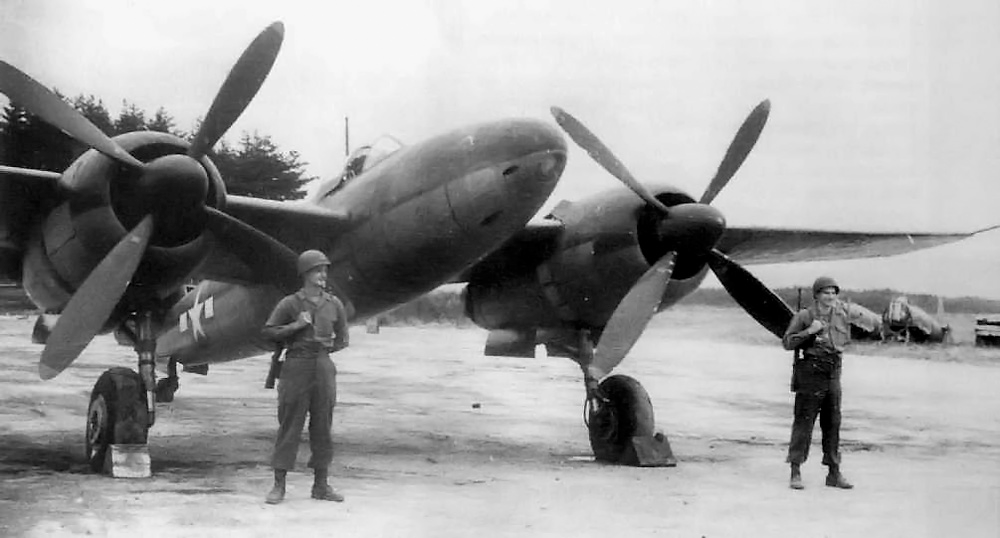
“In the field of machinery the Japanese mind is at a peculiar disadvantage. They are able to turn out an exact copy of any mechanism that comes into their hands, but the type of mechanical imagination which went into its original creation—which, for want of a better term, is sometimes known as Yankee ingenuity—they are at a loss to duplicate.”
In the lead up to, and during the Second World War it seems the US was all too willing to believe its own propaganda on Japanese industrial prowess, and although official intelligence material never descended to the level of the drivel quoted above (from ‘Mechanix Illustrated’) it did repeatedly assume that all Japanese aircraft were copies of Western types. Whilst this was broadly true in the twenties, American Intelligence never noticed (or possibly cared) that the Japanese had attained parity with (and in some areas surpassed) the West by the latter half of the 1930s. This attitude was so ingrained in American thinking that a Western aircraft needed to be conjured up for any new Japanese type to be a copy of (try finding the aircraft that the Kyūshū J7W 震電, ‘Shinden’ (Magnificent Lightning) was copied from: you will struggle). This is particularly evident in the psychological effect the Mitsubishi Zero had on its foes in 1942, an effect only multiplied by the lens of racism through which the Japanese people were inevitably observed. This was followed by a weird scramble to find what American aeroplane the Zero was copied from (Spoiler alert: it wasn’t). It should be noted that extreme racialism and racism was also institutional in Imperial Japan, where the official line often pushed was the notion of the Japanese as a supreme master race.
Join us as we take a look at some other masterpieces of Japanese indigenous design, whether conceived when the Empire swept all before it, or suffering the crushing reality of total defeat.
10. Mitsubishi Ki-83
キ83 (Ki 83)

Produced by a team under Tomio Kubo, who also designed the superlative Mitsubishi Ki-46, the Ki-83 could have been the finest twin-engined fighter of the war. As things turned out it became an obscure footnote in aviation history.
The result of an Imperial Army specification calling for a high altitude, long-range heavy fighter the aircraft that emerged from Mitsubishi’s experimental workshop was possibly the most aerodynamically clean radial engined aircraft ever built and possessed spectacular performance. As well as recording the highest speed attained by any Japanese aircraft built during the war, the Ki-83 was blessed with remarkable agility for such a large aircraft and was fully aerobatic at high speeds. It is recorded to have been capable of executing a 2200 feet loop at 400 mph in 31 seconds. Compared to its direct US equivalent, the F7F Tigercat which also failed to see meaningful service during the war*, the Ki-83 had the same range but was faster and more manoeuvrable. Armament comprised the potent combination of two 30-mm and two 20-mm cannon, all firing through the nose. Unfortunately for this superlative warplane, its timing was appalling.
First flown in November 1944, tests were often interrupted by American air raids and of the four prototypes known to have been completed, three were damaged or destroyed by bombing. The crippling raids by B-29 Superfortresses were also the reason that the Ki-83 never entered production: despite the enthusiasm of both the Army and Navy, by the time it was flying all aircraft manufacturing was focused on interceptors to combat the B-29 and the Ki-83 never received a production order. After the war the sole surviving prototype was evaluated in the US and received glowing praise. With the higher octane fuel available in America the Ki-83 ultimately recorded a speed of 473 mph. Despite being earmarked for preservation the only Ki-83 to survive the war and arguably the finest wartime fighter produced in Japan was last recorded at Orchard Field Airport in Illinois in 1949. It is presumed to have been scrapped there in 1950.
*The first operational F7F sorties took place on 14 August 1945, the war ended the following day.
The Ki-83 made our list of the ten best aircraft of World War II that failed to see service.

From this angle the small window in the fuselage for the optional second crew member is visible just above the tailplane. The outlet at the rear of the nacelle is the turbocharger exhaust.
9. Mitsubishi Ki-15

九七式司令部偵察機, Kyunana-shiki sireibu teisatsuki (Army Type 97 Command Reconnaissance aircraft)
雁金, ‘Karigane’ (Wild Goose)
Although outclassed fairly quickly, the racily art-deco styled Mitsubishi Ki-15 was a brilliant harbinger of what the Japanese aviation industry was capable of and was the first Japanese aircraft to appear in Europe when in 1937 a single example owned by the Asahi Shimbun newspaper, named ‘Kamikaze’ (before that word had any sinister connotations and considered “delightfully named” by ‘Biggles’ creator WE Johns in ‘Popular Flying’), flew from Tokyo to London for the coronation of George VI.

Despite much of the press coverage of this flight turning out to be predictably obsessed with the racial make-up of the Kamikaze’s crew, a process made all the more fun for reporters by the fact that navigator Kenji Tsukagoshi was half British (though attempts to find at least one European parent for pilot Masaaki Iinuma to ‘explain’ his aerial proficiency proved fruitless), a few reports managed to notice that the aircraft was a totally indigenous design, such as British publication ‘Flight’ which reported: “Contrary to expectations, this Mitsubishi monoplane… and its engine do not appear to have built under direct licence from any American firms” but very few pointed out that the 51 hour, 17 minute, 23 second flight over a distance of 15,357 kilometres occurred without any mechanical trouble at all and at a speed unattainable by virtually any contemporary military aircraft. Just to put the icing on the cake, after a whistle-stop tour of major European capitals, Iinuma and Tsukagoshi flew all the way back to Japan in four days, again with no mechanical issues. Given that a mere three years earlier most of the entries into the MacRobertson Air race to Australia had broken down or crashed or taken an insanely long time to reach their destination due to short range and running repairs, this sort of thing should have acted as a sharp wake up call to Western observers (but didn’t).
The less peaceful version of the Ki-15 was utilised as a reconnaissance and light attack aircraft in the Second Sino-Japanese war, being arguably the first truly modern combat aircraft to see service in that theatre, and in developed form during the opening stages of World War II, when its speed was still good enough to render it difficult to intercept, thus setting a precedent for the superlative Ki-46.
Support The Hush-Kit Book of Warplanes: Volume 3 here

8. Mitsubishi A6M
零式艦上戦闘機, rei-shiki-kanjō-sentōki (Type 0 Carrier-based Fighter)
零戦 ‘Rei-sen’ (Zero Fighter)

“I look like Robert de Niro, I drive a Mitsubishi Zero” sang Billy Bragg on his 1991 single ‘Sexuality’, a rare namecheck for a Second World War aircraft in the realm of late 20th century popular music, and although Billy Bragg looks nothing like Robert de Niro and obviously never having sat in, let alone ‘driven’ a Mitsubishi Zero, the very presence of this most famous of Japanese aircraft lends an effortless cool to the song that the inclusion of, say, a Vickers Vildebeeste or a Brewster Buffalo would fail to impart.

The Zero was one of the greatest aircraft of all time, the only Japanese aircraft to be commonly referred to by its official designation by both sides in the Pacific (the odd name ‘Zero’ derives from the last two digits of the Japanese year 2600, during which it entered service and the official allied reporting name ‘Zeke’ never entirely caught on) and the idea of leaving it out of a Top Ten of Japanese aircraft is ludicrous, let alone a Top Ten of Japanese WWII aircraft. However, unlike such aircraft as the Spitfire, the Zero failed to be developed sufficiently to remain in the vanguard of international fighter aircraft and was essentially a spent force by 1945, despite being produced in greater numbers than any other Japanese aircraft before or since. Nonetheless, for a period of two years or so it was, without doubt, the most psychologically shocking aircraft in the sky and the most advanced carrier fighter in the world.

The fact that the Zero caused such a stir amongst the Allies is perplexing: the aircraft had appeared over China well before Pearl Harbor and was a known quantity amongst Chinese aviators and, perhaps more pertinently given the majority if its future foes, the US personnel of the American Volunteer Group (the famed ‘Flying Tigers’). A captured Zero was in Chinese hands as early as February 1940 and was flown and inspected by an American team who sent a highly detailed report to Washington. This report appears to have been filed before it was read as the overriding response to the Zero’s capability once Allied fliers met it in combat was horrified surprise. But the Zero was, after all, immediately preceded by the Mitsubishi A5M which Western observers seemingly failed to notice was the first cantilever monoplane carrier fighter in the world.

Everything You Always Wanted to Know About Soviet World War II Combat Aircraft (but were afraid to ask) here
Despite the suggestion of a swathe of American types that the Zero was alleged to be a copy of, it was, of course, a superlative example of indigenous design led by the brilliant Jiro Horikoshi. Its specification was so challenging that Nakajima didn’t even enter a rival tender: they deemed it impossible to meet. As it turned out, Horikoshi had to use a brand new aluminium alloy (‘Extra Super Duralumin’) which had only been developed by Sumitomo in 1936 to be able to make the Zero light, yet strong enough to fulfil the speed, range and manoeuvrability requirements. The Zero was utterly dominant from its appearance in 1940 to the latter end of 1942, remaining a dangerous opponent to the war’s end in the hands of an experienced pilot. Unfortunately for the Japanese, experienced pilots were in desperately short supply for the latter part of the conflict due to the horrific attrition of the Pacific war. But for two glorious years, if you were Japanese at least, the Zero reigned utterly supreme over land and ocean.
7. Mitsubishi Ki-67
四式重爆撃機, Yon-shiki jū bakugeki-ki (Type 4 Heavy Bomber)
飛龍 ‘Hiryū’ (Flying Dragon)
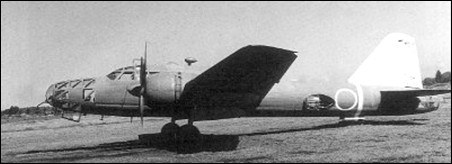
On the whole, Japanese bombers of WWII were not a particularly inspiring bunch. The Navy’s Mitsubishi G4M for example, whilst boasting a beautifully streamlined airframe and spectacular range, was prone to burst into flames if on the receiving end of merely a smouldering glance. The Army’s Nakajima Ki-49, the immediate predecessor of the Hiryū, though less overtly flammable, was disappointing: its bombload meagre and although intended to operate without an escort, its survival was anything but assured against any modern fighter. The sparkling performance of the Ki-67 therefore comes as something of a surprise and the Army were utterly delighted with it.
It should be noted that the contemporary Japanese definition of a ‘heavy’ bomber was not the same as that of other nations and the Ki-67 would have been described as a medium bomber in any other air force. Furthermore its published bomb load and range of 1,070 kg and 2,800 km respectively don’t sound that brilliant when compared with, say, the earlier B-25H Mitchell which could carry more than 2,000 kg and fly 2,170 km. However, published figures even today seem determined to maintain contemporary Allied propaganda in that, whilst not exactly a lie, they suggest the B-25 is better than it actually was, as it could either carry 2,000 kg or fly 2,170 km, not both, the range quoted was only possible with a much reduced load. The Ki-67 on the other hand was quite capable of flying 2800 km with its 1,070 kg bomb load. It could also do so at a speed the B-25 could only dream of and possessed an agility unmatched by any other medium bomber. The Hiryū was not only the finest bomber built by Japan, it was also one of the best aircraft in its class worldwide. So impressive was its performance and manoeuvrability that it was developed into a fighter, a seemingly insane development process as what other aircraft considered a heavy bomber has ever been adapted into a fighter?* The Ki-109 which entered limited production was ridiculously heavily armed with a 75-mm cannon in the nose and intended as a B-29 interceptor but its ceiling was insufficient to attack the high-flying Boeings.

Far more successful in its original intended role as a bomber, the Ki-67 had the misfortune to emerge into a world where Japanese forces were everywhere being pushed back and assailed by vast quantities of Allied aircraft. The Hiryū saw considerable action during its relatively brief service, attacking the US 3rd Fleet off Formosa (now Taiwan) and the Ryukyu Islands and later being used at Okinawa, in China, French Indochina (now Vietnam) Karafuto (now Sakhalin) and against B-29 airfields on Saipan and Tinian. Once the Japanese high command had accepted the use of humans as a missile guidance system in the form of the kamikaze the Ki-67 was used as a basis to develop this approach to its depressingly logical conclusion, the Ki-167 桜団 ‘Sakura-dan’ (Cherry blossom), ‘special attack’ bomber, which carried a 2.9 tonne thermite shaped charge in a large dorsal fairing intended to destroy fortified positions when crashed into them (in tests the charge proved capable of destroying a tank from a distance of 300m, simply through the power of directional blast). Details of the Ki-167’s production and use are obscure and although records are missing, there is photographic evidence that the aircraft definitely existed. It appears that around five examples may have attempted operational missions, thankfully none of these horrific machines ever hit an enemy target, being either shot down or lost to technical issues. An ignominious end to the career of an outstanding aircraft.
*Yeah yeah, the B-17 (kind of).
Hush-Kit gives its readers a lot, if you feel this massive effort deserves support then head over to Patreon and subscribe.
The Hush-Kit Book of Warplanes Vol 1.
Vol 2 can be pre-ordered here.
The Hush-Kit Book of Warplanes Vol 1 here and Vol 2 here
6. Kawasaki Ki-100
五式戦闘機, Go-shiki sentouki (Type 5 Fighter)

Few fighter aircraft in history have made a successful switch from an inline powerplant to a radial (or vice versa) but one of the finest examples of this rare breed was the Ki-100 and its existence was very much a case of force majeure rather than any considered process. The Ki-61 飛燕, ‘Hien’ (Flying Swallow’) from which it was derived was a fine fighter, noted by Allied pilots after its appearance during 1943 for its unusual toughness compared to previous Japanese fighters. As usual, Allied intelligence scouted around for whatever western type the Ki-61 was a copy or licence-built version of and thought maybe it was something Italian, due to its superficial resemblance to the Macchi MC 202, this apparently informing the choice of its reporting name: ‘Tony’. To be fair, in this case they were half right as the Ha-140 engine of the Ki-61 was in fact a licence-built Daimler-Benz DB 601. Unfortunately for Kawasaki, engine supply had never kept up with airframe production, and even if it had, the Ha-140 was proving highly troublesome in service. So much for German technical prowess. By December 1944, 200 engineless Ki-61 airframes were stored in the open at Kawasaki’s factory at Kagamigahara and the situation became totally untenable after a B-29 raid on the Akashi engine plant on 19 January 1945 effectively ended production of the Ha-140. This added considerable impetus to ongoing work to re-engineer the Ki-61 to accept the radial Ha-112 engine, which was in relatively plentiful supply and possessed much better reliability.

Reflecting the desperation of Japan in the last year of war, the conversion of the first Ki-61 to receive the Ha-112 took place in just seven weeks. The new engine was nearly twice as wide as the inline Ha-140, possessed a different thrust line and was 45 kg lighter. Takeo Doi, chief designer of both the Ki-61 and Ki-100 was not keen on the engine change and expressed doubt that the conversion would be successful but in the absence of any viable alternative the work went ahead. Kawasaki followed the same process that Hawker in the UK had earlier followed in the radial engine Tempest II and (ahem) ‘based’ the engine mounting on that of the Focke-Wulf Fw 190. The resulting aircraft exceeded even the most optimistic expectations of the design team and utterly vindicated the decision to re-engine: although marginally slower than the Ki-61, the new Ki-100 could outclimb and outmanoeuvre the previous fighter. Tested against a captured P-51C Mustang the Ki-100 was found to be slower but much more manoeuvrable and could out-dive the American aircraft. Given pilots of equal ability, a dogfight would always favour the Ki-100 – though it was admitted the P-51 could break off and escape at will. Against the F6F Hellcat, the Ki-100 was believed to be superior in every regard.
The Top 10 US Navy aircraft of World War II here.
Sadly for Japan, the Ki-100 only entered service in April 1945 but did see enough service to be considered the most reliable of the Japanese Army’s fighters. In combat, when flown by experienced aircrew (of which few were left by spring 1945), the Ki-100 proved formidable. On 3 June 1945 for example, the 244th Sentai claimed seven Corsairs destroyed and in a huge dogfight with a large formation of Hellcats on 25 July, 12 F6Fs were claimed shot down. It is hardly surprising that the Ki-100 was highly popular with pilots, what is totally remarkable is that the entire career of the Ki-100, from design conception to final surrender took place in a mere 10 months.
5. Aichi D3A
海軍九九式艦上爆撃機, Kaigun kyuukyuu shiki kanjou bakugekiki (Type 99 Carrier-based bomber)

Though the Ju 87 Stuka remains the archetypical dive bomber of the war, it performed most of its deadly work on land. The D3A was the preeminent Axis dive bomber at sea, sinking more Allied warships than any other Axis aircraft and was the first Japanese aircraft to bomb an American target when the Aichi craft spearheaded the attack on Pearl Harbor.
The US edition of The Hush-Kit Book of Warplanes Vol 1 comes out April 2nd 2024…BUT between you and me, you can already pre-order it here and ensure your copy is reserved before it sells out here.
Aichi was a watch manufacturer that decided it was time to get into the aviation field in the 1920s and throughout the interwar years it maintained a close partnership with Heinkel, despite the terms of the Treaty of Versailles forbidding German military aircraft research or production. However, the Japanese delegate on the League of Nations inspection team charged with monitoring this situation simply told Heinkel in advance when they were coming and Heinkel made sure nothing illicit was ever found when they visited: a most satisfactory arrangement for all concerned. The Heinkel influence is clear to see in the D3A with its beautiful elliptical wing, closely related to Heinkel’s own He 70 ‘Blitz’. By the time of the Pearl Harbor attack, the D3A was a proven combat aircraft, having been in action over China for two years beforehand, but the Allies once again decided that this Japanese dive bomber was of no huge concern even as German dive bombers were delivering psychologically terrifying precision strikes across mainland Europe.

Proving that psychologically terrifying precision strikes were not the preserve of the Luftwaffe alone, the D3A opened its WWII account at Pearl Harbor, where admittedly all the ships were conveniently stationary. It then followed this up by sending three US destroyers to the bottom in February and March of 1942 and causing havoc amongst Royal Navy shipping in the Indian Ocean during April, culminating in the sinking of HMS Hermes, the world’s first purpose-built aircraft carrier. During the Indian Ocean raid, D3As achieved hits with 80% of their bombs, against manoeuvring ships at sea which was an incredible success rate. These post-Pearl Harbor attacks were conducted solely by the D3A but most of the successful strikes carried out by the Aichi aircraft were conducted in concert with the Nakajima B5N torpedo bomber, in exactly the same way that the Curtiss SB2C Helldiver would later ride roughshod over Japanese shipping in concert with the Grumman TBF Avenger torpedo bomber.
The glory days for the D3A were very much the initial two years of the war, when the surprising agility and adequate performance of the Aichi dive bomber saw it utilised as a fighter aircraft on occasion but the inexorable improvement in Allied fighters saw the D3A gradually outclassed by its enemies, despite the introduction of the aerodynamically improved D3A2. The much faster Yokosuka D4Y 彗星, ‘Suisei’ (Comet) took over the dive bomber role from late 1943 onwards by which time most of the fleet carriers had been lost, along with veteran Japanese aircrew, and the D4Y could never repeat the remarkable success of its forebear. Yet even once totally outdated the D3A could still inflict terrible damage on its enemies: a D3A sank the American destroyer USS William D Princeton as late as 10 June 1945 in a kamikaze attack.
4. Kawanishi N1K-J
紫電, ‘Shiden’ (Violet Lightning)

The Japanese kept converting heavy bombers into fighters and charming newspaper-owned monoplanes into attack aircraft so it should come as no surprise perhaps that the Navy’s finest landplane fighter of the war should have derived from a seaplane. There were several instances of floats being added to WWII fighters to create a waterborne combat aircraft, the Spitfire, F4F Wildcat, Fiat CR.42 and even the Blackburn Roc were all subjected to this process for example, though only the Zero would see combat in its floatplane form (as the Nakajima A6M2-N). The N1K-J was the only fighter to apply the process in reverse when the float was removed from the powerful N1K1 強風, ‘Kyōfū’ (Strong Wind) floatplane fighter and replaced with wheels to create the N1K-J Shiden. The resulting aircraft, though essentially a lash-up, proved faster than the Zero and had a better range than the J2M Raiden interceptor and was thus rushed into production.

Compromised by the mid-wing configuration of the Kyōfū, intended to keep it clear of spray, the initial N1K-J required unusually long landing gear which were the source of much trouble but in the air the aircraft proved exemplary, demonstrating an excellent turn of speed and a truly remarkable manoeuvrability, boosted by a mercury switch that automatically measured angle of attack and extended the flaps during turns, a system known as the ‘combat flap’. A redesign to eradicate the N1K-J’s most obvious flaw, its mid-mounted wing, saw the aircraft appear in a low-wing configuration as the N1K2-J 紫電改 Shiden-Kai (Kai meaning ‘modified’) with a simplified and lightened structure that consisted of fewer parts and could be built in fewer man hours whilst boasting improved performance. Unfortunately, B-29 raids on the Kawanishi factories meant that only 415 of the improved variant were produced compared to 1007 of the original N1K-J conversion. Both types were somewhat compromised by the intermittent reliability of the Nakajima Homare engine but there was no obvious alternative and the same issues were plaguing other Japanese aircraft. In combat, when the engine was running properly, the Shiden proved formidable, even against the latest Allied fighters. On one occasion for example, the Corsairs of VFM-123 were surprised by Shidens which were mistaken by the US pilots for Hellcats, and a 30-minute aerial combat ensued. Three Corsairs were shot down and another five were damaged while three other F4Us were so badly damaged they were dumped at sea after recovering on their carrier. The Corsairs claimed 10 Japanese aircraft destroyed, but in reality no Japanese aircraft was lost to the F4Us. The reputation of the Shiden was also somewhat magnified by its role as the sole equipment of the 343 Kōkūtai, formed on 25 December 1944 as a particularly unwelcome Christmas present for the Allies. This unit was formed of the Navy’s most experienced surviving fighter pilots, such as Saburo Sakai and Naoshi Kanno, and was equipped with the finest aircraft available. Even during the chaotic conditions prevalent over Japan during 1945, the 343 Kōkūtai exacted a considerable toll from the enemy and the N1K2-Js of the unit remained the equal of any Allied fighter they encountered until the end.

3 Kawanishi H8K
二式飛行艇, Ni-shiki hikōtei (Type 2 Flying Boat)

The Pacific during the Second World War was the largest battlefield in history, yet all but a tiny fraction of it was water. As a direct result the flying boat was of particular value in this huge watery realm, and the best flying boat fielded during the conflict was the Kawanishi H8K, which was the most heavily defended and fastest flying-boat serving with any of the combatants, and remained so until the end of the conflict. In 1929, Kawanishi sent a technical team to the Short Brothers company in the UK, then acknowledged as a world leader in maritime aircraft design (and, perhaps more importantly, a major shareholder in Kawanishi). After building a few examples of the Short Rangoon under licence, Kawanishi mass produced the large and efficient parasol winged H6K which boasted an incredible range, allowing it to undertake unrefueled patrols of up to 24 hours in duration. Unfortunately the H6K was also slow and vulnerable to fighter attack. The H8K was an altogether more formidable machine and represented the greatest technological leap in this kind of aircraft ever achieved.

Designed under a team led by Shizuo Kikuhara, the H8K featured a deep and slender hull and shoulder wing. The hull initially gave serious trouble, the prototype being prone to severe porpoising and the spray thrown up by the bow completely inundated the two inner engines. On one occasion the spray was so bad that the propellers were damaged. Careful redesign, conducted in concert with hydrodynamic scientists from the University of Tokyo eliminated these issues and the H8K’s hull was the most efficient fitted to a flying boat during the war.
As well as performing the same maritime patrol, reconnaissance, and anti-submarine work as contemporary flying boats of other nations, the H8K was also expected to carry out additional offensive tasks as a torpedo carrier and bomber. In the latter role, the H8K was intended to operate in concert with supply ships at which they could refuel and arm, effectively giving them a transoceanic range. The H8K was employed in exactly this fashion in the opening weeks of the war when on 4 March 1942, only a month after it entered service, two H8Ks attempted to bomb Pearl Harbor in a follow up strike after the famous attack in December. Refuelled at sea by two submarines, the flying boats’ target was the oil storage depot at the naval base but cloud cover over the target resulted in the failure of this audacious mission, the bomb load was dropped without being aimed and exploded harmlessly. Nonetheless the H8K’s impressive range allowed it to bomb the United States fleet at Espiritu Santo Island as well as Jaluit Island, the Shortland Islands, and the Phoenix Islands, distances of up to 1,850 km (1,150 miles) and up to 18 hours duration. In addition, reconnaissance missions were undertaken along the Australian west coast, culminating with the bombing of Broome aerodrome by an H8K on 17 August 1943, the aircraft contributed to the sinking of seven US submarines, and it was developed as an effective transport aircraft, though bad luck due to weather struck again when an H8K2-L carrying Vice Admiral Koga Mineichi, Yamamoto’s successor as Commander in Chief of the combined fleet, flew into a typhoon and was never seen again.
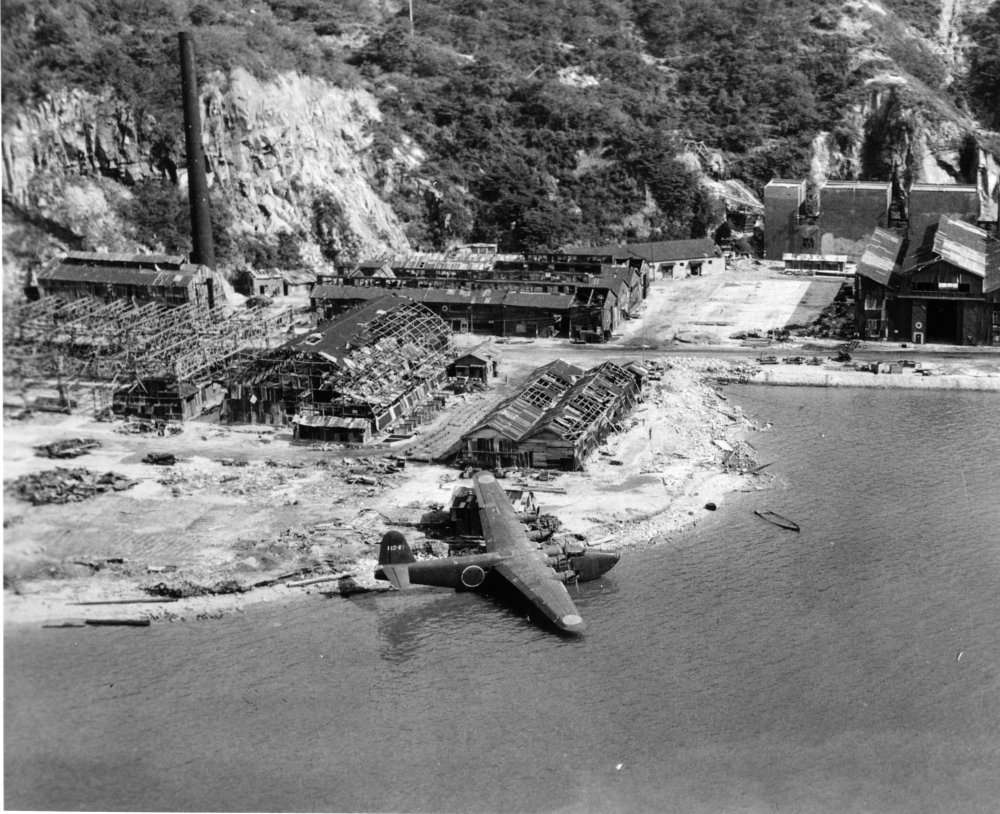
Unlike most other Japanese aircraft, the H8K was considered a difficult target for Allied flyers. It was fast (for its size), rugged, well armoured, and well protected possessing a highly innovative fire suppression system for its huge fuel tanks. It was also fearsomely well armed, with the most produced variant, the H8K2, bristling with five(!) 20-mm cannon and five 7.7mm machine guns. Offensive armament was similarly in advance of its peers, the H8K could carry two Type 91 torpedoes or up to 2000 kg of bombs or mines. The only advantage the H8K did not possess however was numbers, production was painfully slow and after B-29 attacks commenced on the Japanese mainland, was dropped completely so that Kawanishi could concentrate on production of the Shiden-Kai fighter. By war’s end only four examples still existed in broadly airworthy condition. One of these was taken to the US where its hull design heavily influenced that of the postwar Martin P5M Marlin, the last US military flying boat. Meanwhile, Kawanishi, prevented from building aircraft by the Allied occupation switched to general engineering, was renamed Shin Meiwa in 1949 (building cars under the Daihatsu name from 1951) and eventually returned to flying boat construction with the PS-1 which entered service in 1971 and flies to this day, a direct successor to the mighty H8K.
2 Nakajima Ki-84
四式戦闘機, Yon-shiki sentō-ki (Type 4 Fighter)
疾風 ‘Hayate’ (Gale)

Built for an offensive that had stalled by the time it appeared, the Ki-84 barely ever fought the kind of campaign that it had been designed for but even during the chaotic conditions attending the death throes of the Empire that created it, the elegant Ki-84 managed to demonstrate a performance that was as good as the world’s best.
The Ki-84 was conceived in the happier times (for Japan) of early 1942. The Japanese Army and Navy and their respective air arms were trouncing any force that attempted to oppose them but the appearance of superior allied fighters was realised to be only a matter of time. The Army’s standard fighter at the time was the Nakajima Ki-43 隼 ‘Hayabusa’ (Peregrine Falcon), officially the 一式戦闘機, ‘Ichi-shiki sentōki’ (Type 1 fighter), an aircraft in the A6M Zero mould, utilising a relatively low powered engine, light structure and low wing loading to deliver almost unbelievable agility at the expense of more or less all other attributes. This had been supplemented by the Nakajima Ki-44 鍾馗 ‘Shoki’ (Demon queller), the 二式単座戦闘機 Ni-shiki sentō-ki (Type 2 fighter), a dedicated interceptor that focussed on maximum speed and dispensed with the fixation on agility displayed by all other Japanese fighter aircraft and was thus regarded as too specialised to be regarded as a successor to the Ki-43. A fighter that combined the best features of both designs was sought and the Ki-84, designed by Yasumi Koyama, was the brilliant result, the finest Japanese fighter aircraft to see service in large numbers during the conflict.
Top Italian aircraft of World War II here
On its combat debut in China during the Japanese offensive of August 1944, the Ki-84 enjoyed a situation that would not be repeated: facing the US 14th Air Force which was critically low on fuel and supplies, the first unit to receive the Hayate was the 22nd Sentai, formed of highly experienced pilots most of whom had been part of the Hayate service trials unit and were therefore well versed in the qualities of their aircraft. The poor build quality that would afflict the Ki-84 later in its career had yet to appear and the aircraft created quite the impression on its foes. Here was an aircraft that displayed all the virtues of earlier Japanese fighters but possessed none of their shortcomings. It was fast, powered by the lusty 18 cylinder Nakajima Homare with water-methanol injection and delivering 2000 hp at take-off; well armed with two 13-mm Ho-103 machine guns in the fuselage and two 20-mm Ho-5 cannon in the wings; tough: featuring self-sealing fuel tanks and armour protection, both previously largely absent from Japanese fighters; and manoeuvrable: on its debut the Ki-84 could outclimb and outmanoeuvre any Allied aircraft then in service. Intended from the outset as a multi-role combat aircraft, the Ki-84 featured hardpoints for up to a 250kg bomb under each wing and was utilised as a highly effective fighter bomber, notably during the fighting in Okinawa.

It couldn’t last of course, Allied bombing and blockades took their toll on Japanese industry and Nakajima was no exception. Forced to rely ever more on unskilled labour such as students (and having been a student, I know the lowly standards, slapdash approach, and desperation that this implies), whilst dealing with an ever lower quality of raw materials and components, the build quality of the beautiful Ki-84 began to suffer. By early 1945, standards were so lax that individual Ki-84s exhibited seriously differing performance. Hydraulics failed, the Homare engine proved troublesome, undercarriage legs even snapped on landing due to incorrectly tempered steel. At the same time, the old story of combat attrition saw the quality of Japan’s fighter pilots inexorably dwindle. Nonetheless, a Ki-84 in decent shape gave even a mediocre pilot a fighting chance against the ever-increasing hordes of excellent Allied aircraft, and at least there were plenty of them: the Hayate was the most numerous Army fighter by early 1945.
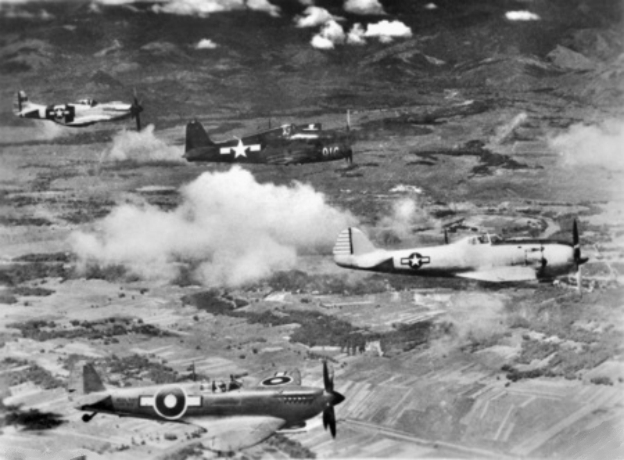
Testing of a captured Ki-84 at Wright Field in the USA, highly impressed American pilots and technical staff. Despite noting that “very little effort has been made to make the pilot’s job easy or safe”, the report highlighted the “unusually strong” construction and states “the handling and control characteristics of the aircraft are definitely superior to those of comparable American fighters” concluding that the aircraft “may be compared favourably to the P-51H and P-47N” which is praise indeed given that the P-47N was barely operational before VJ-day and the P-51H failed to enter service before the war’s end, yet the test aircraft was a fairly early Ki-84. Part of the reason for this spectacularly good showing was the superior fuel available to the US testers with a higher octane rating than that the Ki-84 was expected to consume in service. Decent fuel considerably improved performance (the captured example clocked 427 mph at 20,000ft whilst the official Japanese top speed at the same height was 388 mph) and eliminated any concern about the reliability of the Homare engine. Noted British test pilot Eric Brown was similarly impressed, comparing the Ki-84 favourably against the Griffon powered Spitfire Mk XIV and stating it was the finest Japanese aircraft he flew. Had it been available earlier, before the industrial rot set in and all the best pilots were dead, the magnificent Hayate could have been a very significant problem for the Allies indeed.
1 Mitsubishi Ki-46
一〇〇式司令部偵察機, Ichi rei rei-shiki shirei-bu teisatsu-ki (Type 100 Command Reconnaissance Aircraft)
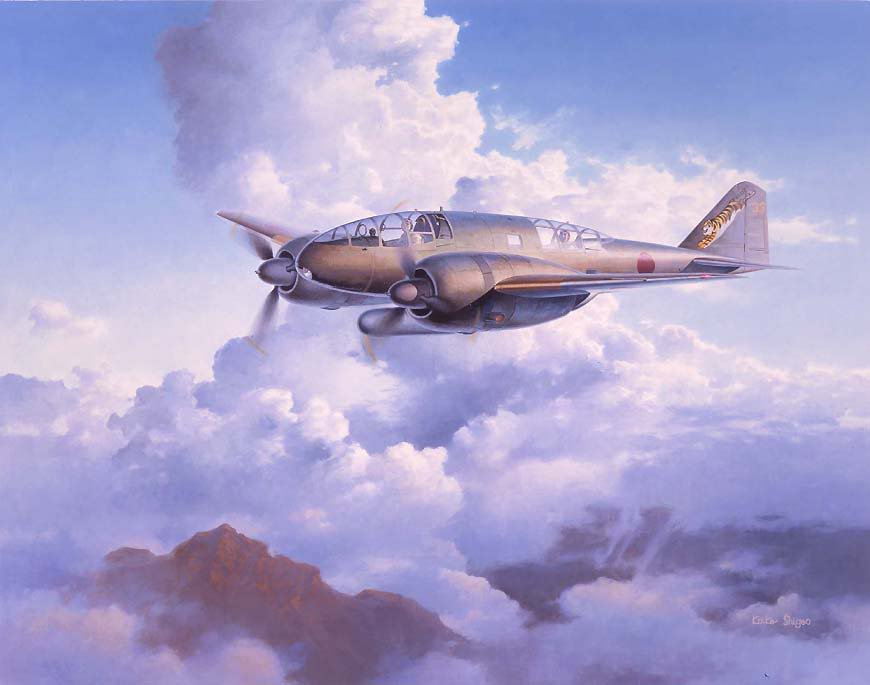
Reconnaissance aircraft seldom get the attention they deserve, performing totally essential work, usually alone and often unarmed. In the Ki-46 the Japanese possessed the world’s finest example of this type of aircraft. As a reconnaissance platform it was unmatched by any other machine until the appearance of the Mosquito and proved maddeningly difficult to intercept throughout the conflict. As late as September 1944, a Spitfire Mk VIII (itself no slouch) required the removal of armour and a pair of machine guns to achieve the performance necessary to effect an interception. According to an oft-repeated claim, the Germans were impressed enough that they attempted to obtain a manufacturing licence (without success), though a reliable original source for this tale remains elusive. If this is true however, it paints the Ki-46 in a remarkable light, for the race-obsessed Nazis to admit that a superior aircraft was built by an ‘inferior’ people was praise indeed. What is not in doubt however, is the fact that the Ki-46 was the only Japanese aircraft deemed of sufficient interest to be sent to the Soviet Air Force technical institute in 1945 for further evaluation. Even the Japanese Navy, who detested the Japanese Army and everything to do with it, were forced to concede that the Ki-46 was superior to any aircraft they themselves possessed and used it for missions over New Guinea and Australia.
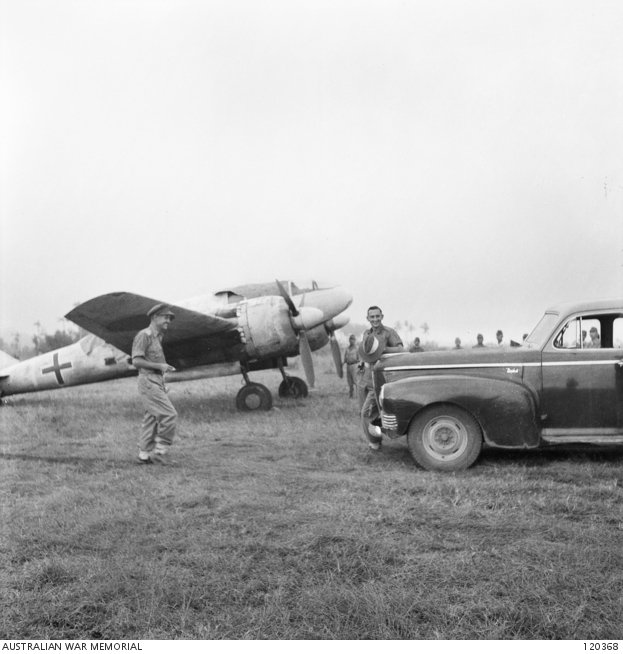
Curiously however, the Ki-46 programme started with the decidedly unimpressive Ki-46-I. Despite the Japanese aircraft industry being exceptionally good at streamlining radial engines (and the Ki-46 was possibly the finest exponent of this trend) the Ki 46-I handled poorly, failed to meet performance estimates and was used largely for evaluation and training. An engine change to the Mitsubishi Ha-102 featuring two-stage, two speed supercharging transformed the aircraft and when the Ki-46-II entered service in July 1941 its performance rendered it immune from interception. Throughout 1942 and 43, the Ki-46 swanned about in near perfect safety, with only an occasional unlucky or careless example falling to Allied fighters. The Ki-46-II was built in the greatest numbers of any variant and remained in service until the end of the war by which time its performance advantage had diminished somewhat but was still potent enough to allow it a decent chance of survival in Allied controlled airspace which was more than could be said for most Japanese aircraft from mid-1944 onwards.

The improved Ki-46-III was faster still due to a weight reduction programme, the adoption of more powerful Ha-102 engines with direct fuel injection, and a revised fuselage design resulting in near perfect streamlining. In this form it could achieve a maximum speed a shade over 400 mph. 654 examples of the Ki-46-III were built, a total that would have been higher but the combination of bombing and an earthquake at Mitsubishi’s Nagoya factory crippled production. The development of a replacement aircraft, the Tachikawa Ki-70, resulted in an aircraft with inferior performance and as a result the Ki-46 was improved further to become the turbo-supercharged Ki 46-IV. Although it never entered production due to the difficulty of manufacturing the turbochargers, its performance was incredible: in February 1945 two of the prototypes flew from Peking to Yokota in 3 hours 15 minutes, covering 1,430 miles at an average of 435 mph. By contrast the cruising speed of the contemporary, and much vaunted, Mosquito PR Mk XVI was 318 mph and its absolute maximum 407 mph. Loved by its crews and respected by its enemies, the Ki-46, designer Tumio Kubo’s masterpiece, was for most of the war in a class of its own.
Correction: the initial variant of the Shiden was the N1K1-J, not the N1K-J.
The formidable Mitsubishi Ki-83
キ83 (Ki 83)

Produced by a team under Tomio Kubo, who also designed the superlative Mitsubishi Ki-46, the Ki-83 could have been the finest twin-engined fighter of the war. As things turned out it became an obscure footnote in aviation history.
The result of an Imperial Army specification calling for a high altitude, long-range heavy fighter the aircraft that emerged from Mitsubishi’s experimental workshop was possibly the most aerodynamically clean radial engined aircraft ever built and possessed spectacular performance. As well as recording the highest speed attained by any Japanese aircraft built during the war, the Ki-83 was blessed with remarkable agility for such a large aircraft and was fully aerobatic at high speeds. It is recorded to have been capable of executing a 2200 feet loop at 400 mph in 31 seconds. Compared to its direct US equivalent, the F7F Tigercat which also failed to see meaningful service during the war*, the Ki-83 had the same range but was faster and more manoeuvrable. Armament comprised the potent combination of two 30-mm and two 20-mm cannon, all firing through the nose. Unfortunately for this superlative warplane, its timing was appalling.
First flown in November 1944, tests were often interrupted by American air raids and of the four prototypes known to have been completed, three were damaged or destroyed by bombing. The crippling raids by B-29 Superfortresses were also the reason that the Ki-83 never entered production: despite the enthusiasm of both the Army and Navy, by the time it was flying all aircraft manufacturing was focused on interceptors to combat the B-29 and the Ki-83 never received a production order. After the war the sole surviving prototype was evaluated in the US and received glowing praise. With the higher octane fuel available in America the Ki-83 ultimately recorded a speed of 473 mph. Despite being earmarked for preservation the only Ki-83 to survive the war and arguably the finest wartime fighter produced in Japan was last recorded at Orchard Field Airport in Illinois in 1949. It is presumed to have been scrapped there in 1950.
*The first operational F7F sorties took place on 14 August 1945, the war ended the following day.

From this angle the small window in the fuselage for the optional second crew member is visible just above the tailplane. The outlet at the rear of the nacelle is the turbocharger exhaust.
I flew the Danish F-35 Draken
Dirk Reid swapped his RAF Tornado for a Saab Draken in the Royal Danish Air Force. Here he describes the excitement and idiosyncrasies of the fabulous F-35 Delta Dragon.
“It was a single-seat, single-engined aircraft, yet went for 13 years without any hull loss – compare that with Jaguars, Harriers and F-104s.
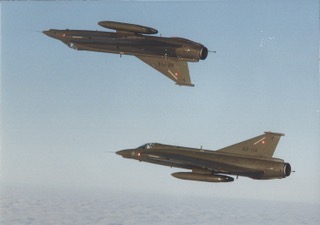
Draken in three words..
Quirky, innovative, versatile
What was the best thing about the Draken? Adaptability – our roles included recce, anti-shipping, EW, air-ground, other versions were capable air defenders in their time. And the radio, which had hundreds of pre-studded frequencies – just rotate one knob to find the airbase, then press the button marked ‘Radar’ for the radar frequency, the one marked ’Tower’ for the tower frequency etc etc
..and the worst? Being a double delta, it’s low-speed handling. In a stall, the rear section of the wing would lose lift first, whilst the forward part would continue flying, hence the nose came up. Then the forward part lost lift, so the nose would drop, until increased speed caused it (but not the rear part) to fly again, so the nose came up again….. This was called a super-stall, recovery required the stick to be pushed forwards as the nose came down, until both parts of the wing were creating lift, and then pulling out of the subsequent dive – if you had 10,000 ft to play with. Hence the front of the stick was fitted with the ‘knife’, a narrow blade of metal that, when the AoA, or onset of AoA was too high, rapidly vibrated against the pilots fingers causing a natural immediate releasing of the stick. Also, the fuel-state indications in the cockpit, which led directly to the first hull loss for many years. The SAAB designers were very good at taking human qualities into account when developing the aircraft, but this was a rare lapse.
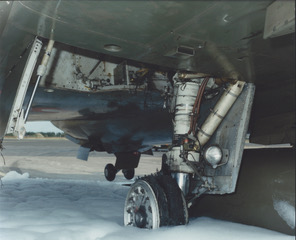
What is the biggest myth about the aircraft? It’s short-field capability. Despite the parachute, landing at Rønne, Bornholm, which was 6,500ft long, needed you to get it on the numbers.
What was your first flight like? Such a long time ago! Thoroughly enjoyable I recall, but a blur of activity with plenty of fuel checks – I was used to turbofans, not a turbojet!
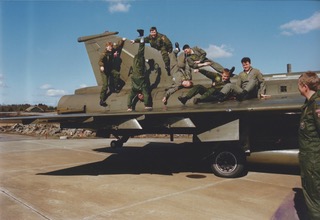
What was your most memorable experience flying the Draken? Probably the long-range recce missions into the far east of the Baltic. We’d launch from Karup and do a training mission on our way to Rønne, where a very lean support operation would give us fuel and a fresh parachute, which we’d have to re-fit into the aircraft. The recce from there was usually a hi-lo-hi profile, with a pair of F-16s as top cover to provide radio relay. We’d do as much as we could before pulling out on fuel minimums for the cruise home with the film for the eagerly-awaiting Photo Interpreters. If we got low on fuel, it was hard to resist the temptation to slow down, which had worked very well on my previous aircraft, but the double delta produced a max range speed of 450kts at low-level or 0.87M at height!
What was the role of the Draken and in which unit did you fly? It had many roles, but 729 Sqn was primarily a recce and anti-shipping outfit. We did a lot of ship recce in the Baltic, the cameras could be mounted to face forwards, sideways, down and rearwards, there was even a 42 inch sideways-facing lens that was very useful for peering deep inland. In the anti-shipping role we weren’t equipped with any guided missiles, so weren’t blue-water capable, more using rockets, bombs and bullets for opposing landing forces.
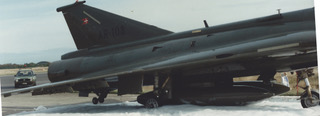
A. Instantaneous turn rates
Excellent for it’s generation, but no match for an F-16
Sustained turn Needed the burners in! Incidentally, I was used to the Tornado, where the engine ran at max dry and the reheat was varied by the throttle once ‘through the gate’. In the Draken, the burner was on/off, and the engine speed was varied with the throttle
C. Climb rate Good for a mud-mover, but not equal to the fighter versions – we generally carried a lot under our wings.
D. General agility Not brilliant once the speed came off and the double delta started inducing drag.
E. High angle of attack performance See reference to the super stall above
F. Off-base operations Bread and butter to the Swedes, and designed into the airframe, but we never practised it.
G. As a fighter No radar in our version! We practised ACT and did well in a visual fight against older aircraft.
H. Sensors Day VFR only – we had a HUD for weapon aiming and a radalt and a laser to get the data into the weapon-aiming system – all our ordnance required visual acquisition of the target. Ironically, it had brilliant lighting for night close-formation flying, in stark contrast to my previous aircraft, the Tornado – supposedly designed for night flying!

I. In terms of combat effectiveness and survivability? The aircraft was at the end of its life and we retired it from RDAF service when I was there. The Danish were very innovative in terms of the tactics they used, but ultimately the avionics fit limited its capability.
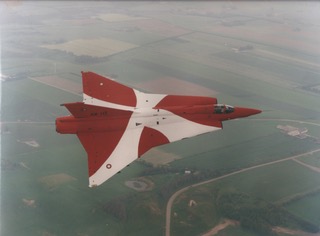
J. Cockpit layout and comfort? Of its day – a scattering of switches and instruments, with a mid-life update thrown in! It was also on the small side, not ideal for an ex prop forward. During landing, aerodynamic braking was normally used, with the aid of the fourth set of wheels in the tail, to slow the aircraft down. There was a radio transmit switch at the rear of the stick which could get involuntarily operated if an excessive belly got in the way, causing much embarrassment.
What should I have asked you? About the safety record. It was a single-seat, single-engined aircraft, yet went for 13 years without any hull loss – compare that with Jaguars, Harriers, F-104s etc.
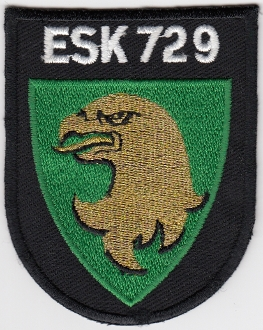
Did the aircraft have a nickname? It’s called the “Dragon” – no need for a nickname!
Which weapons did you deploy and which was the most spectacular from the cockpit? US dumb bombs, CBUs, cannon and rockets – firing 2 full pods of 2.75 inch rockets was definitely one of my highlights!
Did you fly DACT against types and if so which types and which was the most challenging? Not really, plenty of low-level evasion against RDAF F-16s though.
Do you love the aircraft? Super-reliable and with some outlandish features – what’s not to like?
What was unusual about Danish air force tactics and culture? The culture was very different to the RAF, which consumed all and became a way of life. The RDAF was unionised, worked a set pattern of hours through the week and the workforce scattered to the four winds when the working day had finished. There was a very open and honest culture when it came to safety, which I am sure contributed to the impressive record alluded to earlier. Tactically, they were very free-thinking, willing to innovate and try new ideas.
Dirk Reid/Sqn Ldr/729 Sqn RDAF/1991- 94.
Hush-Kit gives its readers a lot, if you feel this massive effort deserves support then head over to Patreon and subscribe. Grab yourself a copy of the highly acclaimed The Hush-Kit Book of Warplanes Vol 1. Vol 2 can be pre-ordered here.
Winkle: The Extraordinary Life of Britain’s Greatest Pilot
Hush-Kit talks Winkle with Beaver
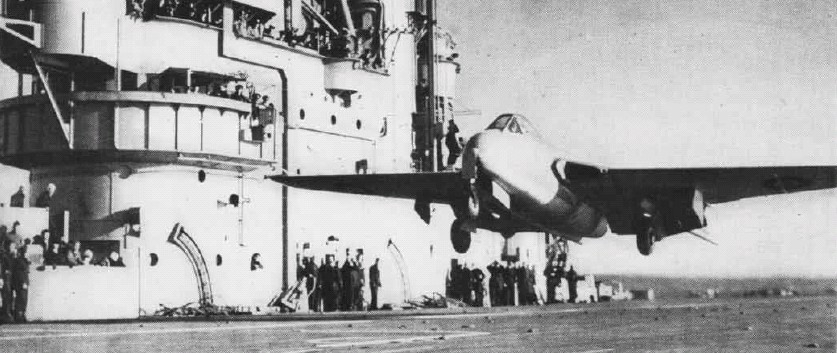
Captain Eric Melrose ‘Winkle’ Brown is a strong candidate for being the greatest test pilot of the 20th century. Paul Beaver’s forthcoming book takes a look into the psychology of this cool-headed Scottish master pilot and the human story of Winkle’s success. Away from the his undoubted flying brilliance, lurk awkward questions about his thwarted desire to fight on the Fascist side in the Spanish Civil War. We met veteran aviation writer Paul Beaver to find out more.
Who was Eric Brown and why is he important?
Captain Eric Melrose Brown – known to everyone, except his close friends as Winkle was a naval test pilot, squadron and station commander who flew more types, carried out more deck landings and carrier recoveries than one pilot before or since. His record is unlikely to be bettered because there just aren’t the number of types flying. His 487 types logged does not represent marks either – he flew fourteen marks of Spitfire for example.
Winkle is important because he was the greatest handling test pilot of all time. He also mastered difficult machines with skill and still found time to be at important 20th Century events – the Olympics in Berlin, Germany pre-war, the flight of the first jet in Britain, interviewing Gring, identifying Himmler, Bergen-Belsen, and many others. He was friends with statesmen, pilots and industrialists and even called Shirley Bassey and Glenn Miller ‘friends’.

What were his three favourite types and why?

Over forty years of friendship, I chatted to Winkle on numerous occasions about his favourites and least favourites. We draw up a list which is to be in WINKLE – the biography in full. Top Trumps for Eric were (1) de Havilland Sea Hornet which he took to the deck on 16 August 1945 and which he cited as having all the advantages of the Mosquito but very few, if any, of the vices; (2) Messerschmitt Me 262A which had a special place in his heart and which he first flew on 24 June 1945 at Grove in Denmark. He would have been delighted to see the Me 262 at RIAT this year and would still marvel at its advanced wing design; (3) Supermarine Spitfire Mk XIV because of its high tactical Mach number and which he reckoned was the best of the breed. He liked the Mk IX when he flew it in combat, but he rated the Mk XIV as outstanding.
- And three types he didn’t like (and reasons why)
Eric loved aeroplanes and helicopters, he loved flying and testing, but he often said he was lucky to get away with flying some types. His least favourite aeroplanes of all 487 flown were (1) the General Aircraft GAL/56 which said, “don’t come much worse than this one” and another time he told me that flying it was a “battle of wits”; (2) de Havilland DH 108 Swallow, the test pilot killer which cost the lives of two key test pilots between 1946 and 1950. Eric thought he survived flying it in 1948 because of his small stature – hence the nickname Winkle – which meant that his head didn’t hit the canopy in violent oscillations; (3) the Fairey Spearfish which Eric would also reference to me as a “real old cow”.

It often said Winkle performed the first twin-engined aircraft take-off from a carrier, yet there is a rival French claim – which is true?
Winkle’s claim holds. The French claim is undocumented and there is no real evidence. Just like the American claim to the first jet landing on a carrier.
What was Winkle’s role in the Spanish civil war? Is it true he said he didn’t mind which side he was fighting for?
In 1945, there is a record of a throw away line from Eric after his jet deck landing aboard HMS Ocean where he admits to the Daily Mail to fighting in the International Brigades in the Spanish Civil War. I spent a good few weeks working on this clue and found, in a logbook and from interviewing his other friends that there was something in the story. In the biography WINKLE, I go into detail about the flying experiences he had but caution that there is no passport or other travel evidence to support his claim. In terms of his politics, he had just been in Germany and met pilots of the Condor Legion so his motivation was supporting Franco rather than the Communists. Fate decreed otherwise. His politics were conservative (small c), unionist and Monarchist so not the politics of a socialist who might join the International Brigades which had folded by 1939 anyway. The biography is focussed on Eric’s life and motivations; it’s the man not the machines that will interest the reader.

What was he doing in the Second World War?
Eric’s wartime experiences take up much of the Biography and are too many and too rich in interest to relate in an interview. Read the book! He was commissioned into the Royal Navy, served on a fighting squadron, was torpedoed, became a test pilot, got married, became the wizard of deck landings and flying under bridges, saw combat over Occupied France and commanded the Enemy Aircraft Flight at RAE Farnborough. He took fewer than ten days leave!

What were his experiences of Nazism in the post war German air force?
Eric was essentially non-political. He liked Germany pre-war but had little contact with the Nazi Party until he was arrested by the SD (not the Gestapo) in September 1939. His next encounter was in 1945 when Bergen-Belsen was liberated that April and then leading the aeronautical test flying of the Farren Mission to Germany’ Post-war, he met U-Boats commanders and fighter aces – he loathed the use of Nazi as a shorthand in popular media for everything German during the war. There were no Nazi Bombers, he would say, just German ones, some of which were flown by Party members and many which were not.During Eric’s time as the Head of the British Naval Air Mission to Germany in 1958. Eric and his wife, Lynn, were guests of a German naval club in Kiel. The Browns were horrified to see the Nazi memorabilia and left. The Club was closed down shortly afterwards.
What made him such a good test pilot?
This is the nub of the biography. The Hon Dr Katherine Campbell, the noted psychologist and biographer of her father, Sholto Douglas, and I discussed Eric’s test flying from a medic’s point of view. She reckons, and I agree, that Eric was able to compartmentalise his life when flying. He shut out everything but the task, even on the day his father died and the day his son was born prematurely. Eric also trained for every eventuality and had a plan for every flight, including likely (and unlikely) emergencies. “Know the numbers,” he told me when I started military flying in the Army Air Corps and remember to have two escape routes already in your mind. The rest is covered in the book!
What should I have asked you?
Perhaps about his thoughts of the aircraft which got away: (1) X-15 which he could not fly because of his nationality; (2) the SR-71 because when it came into service, he had retired and (3) the Miles M52, about which I have a different take to the preserved wisdom.*
* I pressed Paul to share his views on the M52 but he refused and instead suggests we learn his views in his forthcoming book
Paul Beaver retired from the British Army Reserve in 2012. He was commissioned into the Army Air Corps (V) in 1987 and ended his career as Colonel (Reserves) in the Joint Helicopter Command. In the intervening period he flew Scout, Squirrel, Gazelle and undertook an Apache course in America in 2009. During various exchanges and visits, Paul flew German, French, Italian, Spanish and US National Guard single-engined types including Mike-model Hueys with the latter.
Hush-Kit gives its readers a lot, if you feel this massive effort deserves support then head over to Patreon and subscribe. Grab yourself a copy of the highly acclaimed The Hush-Kit Book of Warplanes Vol 1. Vol 2 can be pre-ordered here.
IN COMBAT WITH LOCKHEED F-117 NIGHTHAWK PILOT MAJOR ROBERT ‘ROBSON’ DONALDSON

The F-117 Nighthawk was a ‘silver bullet’, able to effortlessly penetrate the best-defended air spaces in the world by virtue of stealth, as first demonstrated to the world during Operation Desert Storm against Iraq. Major Robert ‘Robson’ Donaldson describes taking the stealth fighter to war.
THREE WORDS TO DESCRIBE THE F-117?
Deadly. Stealthy. Mysterious.
THE INVISIBLE MEN
The personality of the pilots chosen was actually a big deal since everyone was handpicked. In peacetime training, we were 200
miles north of Las Vegas at our base on the Tonopah Test Range, Nevada, for four to five days each week, so we all had to get along because we were in this same fishbowl. I think we were all of the same mindset, that even if the mission was a one-way suicide, we would still go. In wartime, I had to trust my fellow pilots with my life, and I did.
MEETING THE GHOST

I first saw the F-117 in a closed hangar at our base in Tonopah. Each jet had its own hangar that was shut closed during daylight hours to hide it from spying eyes and Soviet satellites. I walked into a dark hangar with my escort pilot and then the lights came on. There sat a futuristic spaceship with a large American flag hanging overhead. I was stunned. I thought, That’s not real. . . It must be a mock-up or something! It defied all aviation logic. I went over and touched the jet, and then started asking my escort pilot a lot of questions. We walked around the outside and I asked if I could sit in the cockpit. He said yes so I climbed up the ladder and sat in the seat. It was a very spacious cockpit compared to the F-16, which I had just come from. The stick was in the centre like a conventional fighter cockpit and I could see that the design was ‘hands on throttle and stick’ [HOTAS]. I asked about the various countermeasures the jet carried and his answer to all those questions was: ‘Not needed.’ I then closed the canopy and it felt like I was closing my coffin lid. The visibility out the front was very poor because of the location of the HUD [head-up display], and there was no rearward visibility; the side windows were really the only place to see out (very unlike the almost-unlimited visibility I enjoyed in the F-16). I was not yet in class to learn how to fly and tactically employ the jet, but I was really excited to be a part of the programme and get started learning.
TAKING THE ‘BATPLANE’ TO COMBAT
We had a tremendous amount of confidence in the capability of the jet to slip through the Iraqi integrated air-defence system and
precisely deliver our munitions on target on time. The F-117 had been extensively tested against all aspects of a Soviet IADS[integrated air defence system] in the USA. Also, several times during the Desert Shield build-up we ran multiple F-117s right up to the border with Iraq to see what the Iraqi reaction would be: no response was detected by the assets that collected ELINT [electronic intelligence] so we positively knew we could slip by them undetected. Our only concern as pilots was the ‘golden BB’, a random bullet of AAA [anti-aircraft artillery] that would hit our jet and take us down. With vast amounts of bullets from 23-mm, 37- mm, 57-mm, 85-mm and 100-mm guns, this was a very real danger. Iraq was a fully armed nation and the tremendous amount of AAA shot up was the same on the last night of war as it was on the first night. My most memorable mission during Desert Storm was when I was tasked to destroy two bridges in south-east Iraq, close to the border with Kuwait, in anticipation of the ground-assault phase. The significance of the bridges was obviously the Iraqis’ ability to resupply their troops in Kuwait. After a top-off of fuel from the KC-135 tanker near the Saudi−Iraqi border, I entered Iraq in our ‘stealthed-up mode’ (all external lights off, no comm., no antennae extended). Saddam Hussein had already set the oil wells on fire in Kuwait, so as I approached the area I could see there was a heavy black cloud from those oily fires obscuring the ground. My profile
called for bomb release somewhere around 12,000 feet but since our rules of engagement required a positive identification of the
target, I knew that would not be possible from that altitude. I did not want to return to my base with those two GBU-10 bombs
(2,000 lb each with a laser-guided kit). Knowing the terrain is flat in that area, I decided to descend to get below the oily cloud-layer so as to be able to positively ID the bridges, which were about seven miles apart from each other. I had to get down to about 700 feet above ground level in order to be in the clear. Underneath that black cloud was an absolute Dante’s Inferno scenario – a sight I’ll never forget. I went over my IP [initial point: an easily identifiable feature used as a starting point for the bomb run] and lined up on the first bridge. Visibility was actually quite good because the oily overcast reflected the fires light underneath. I
pushed up the throttles to go as fast as I could and my inertial navigation system had positioned the cross hairs of my laser sight right on the bridge, so visual ID of the target in my cockpit was accomplished. I aimed for the far end of the span on the bridge.
The single bomb released very close to the target and I ripped the throttles to idle to slow my speed so that the laser would not
gimble – low to the ground and fast, the laser would run past the span before my bomb hit, thus rendering it a dumb bomb). Ripping the throttles to idle caused the jet to decelerate so that I had time to keep the laser beam on the span but it also caused my
head to tumble so that I felt like my head was going end-over-end through space. The bomb impacted the bridge and the explosion
caused the span to drop into the river. A nanosecond later I saw on my screen an Iraqi army truck drive off the bridge where the
span had been a moment before. I had no time to process that snapshot as my jet was rocked by the explosion of my own bomb,
turning me about 135 degrees upside down and disengaging the autopilot.

I managed to recover the jet about 400 feet above the ground, climb back up to 700 feet and re-engage the autopilot. The fragmentation envelope of a 2,000 lb bomb is 2,500 feet in all directions upward and to the sides of the impact, so from 700 feet above the ground I was well within the frag envelope of my own bomb. I knew that but had decided to take my chances anyway. Once I was right-side up, I immediately looked at my engines to confirm they were running and to check my fuel status. Both were good so I didn’t think I had fragged myself. So a lot was happening in a very short period of time and now I had to line up on my second bridge, which was rapidly approaching, but this time I knew what to expect. Once again, the deceleration, the tumbling, the explosion, a dropped span, and being blown upside down were all that I had anticipated, only this time I climbed up after I recovered the jet and headed for the air-refuelling point. I carefully looked over the engine instruments and my fuel status, and once again all seemed normal. After I had post-strike air-refuelled, I had about 90 minutes to reflect on that sortie. It was very satisfying to drop those two bridge spans but I wasn’t 100 per cent sure that the Iraqi Army truck driving off the span actually happened or if it was my mind playing tricks on me. I’m also pretty sure that since the bombs I dropped had a slight delay-fuse, the bombs penetrated the concrete and then detonated just under the bridge so that a good portion of the bomb fragments would have been trapped underneath the bridge and not gone up in the air into my jet. I landed back at base and our routine was to look the jet over on the outside after each mission and make sure all was intact. So I told my crew chief I was a bit concerned but we both looked the jet over carefully and did not find any self-inflicted holes. We have a saying in the fighter community that God takes care of dumb farm animals and fighter pilots. I’m not sure which group I’m in! Next was a stop and debrief with our intelligence people to assess the strike via the VHS camera film. Sure enough, right there on film was the Iraqi Army truck driving off the span. All in all, it was a very surreal night and I was happy to finally crawl into bed and let my brain and body get some sleep after a five-and-a-half-hour mission.
Hush-Kit gives its readers a lot, if you feel this massive effort deserves support then head over to Patreon and subscribe. Feel free to order The Hush-Kit Book of Warplanes Vol 1. Vol 2 can be pre-ordered here.
The Hush-Kit Book of Warplanes Vol 1 here and Vol 2 here

I flew the B-47 nuclear bomber

The Boeing B-47 Stratojet nuclear bomber first flew in 1947 and changed everything. Though it flew the same year as USAF’s first jet bomber, the North American B-45 Tornado, the B-47 was far superior – and pointed the way to the future. Its influence on later jets cannot be overstated, and every Boeing or Airbus at the airport, as well as the immortal B-52, are descendants of the sleek B-47. Of the 2000+ B-47s built, many were part of LeMay’s Strategic Air Command, the most lethal force in history. Colonel G.Alan Dugard (Retired) flew the B-47 in the 509th Bomb Wing, here he gives the low-down on the bomber that made the modern world, and threatened to destroy it.
Describe the B-47 in three words…
Solid, stable platform.
What was the best thing about the B-47?
Compact, and 360-degree-visibility cockpit
..and the worst?
Location of trim items. Wheel for elevator trim was located right side near the throttle quadrant. Rudder trim back of quadrant.

What is the biggest myth about the aircraft?
Lack of manoeuvrability. You could actually roll the B-47
Did you feel confident that the aircraft would have been survivable in a war?
At the stage I flew it, it had high rate of survivability at low level, not at altitude.
What was your most memorable experience flying the B-47
I was flying a normal night mission, programmed for a KC_135 refuelling near the Canadian border going west a nav-leg and a low-level route down south. We had completed a 35,000-pound offload just south of Cleveland and attained our cruising altitude and started our preparation for the nav leg. The co-pilot had dis-engaged his seat to put the sextant in place. When I felt a grabbing to the right, followed by a sever pull to right and a great flash of light. Looking out to the inboard nacelle the # 4 engine was deteriorating from the explosion and the #5 engine was also on fire. Both engines were shut down. I told the co-pilot to return his seat to the locked position and told our “Forth Man”, seating in the lower aisle to fasten his seat belt. I called Cleveland Center, declaring a “Mayday” and asked for the nearest airfield to land at. Our biggest problem was our gross weight due to max onload of fuel. I was told to proceed to Lockbourne AFB in Ohio and was given a heading to the base. I contacted Approach Control for Lockbourne, told them the situation. I asked them if they had a dump area for my wing tanks and after a pause they said yes, but they would have to evacuate the GCA facility before I could drop the tanks. We were dumping fuel as fast as we could and when arriving at the base were still too heavy to land. We were fairly stable and so decide to just burn down to a landing weight, and still dumping*. As the tips emptied we were at the max weight for landing and made a landing, not the best I ever made, but good enough. Examination of the two engines’ showed extensive damage to both nacelles as well as the engines.
*Some have questioned this, asking if the B-47 was capable of fuel dumping, this may have been misremembered

An interesting second choice:
First deployment over the pond and refuelling with a KC-97 Tanker. The 97 had a ceiling of about 15,000 feet and a speed that was within a marginal point of the B-47 stall speed. It was a clear night at altitude, 28,000 flight level, but the refuelling took place at the tanker’s ceiling, and the tops of the undercast was 17,000 feet. The descent from clear skies to the Tanker was a radar rendezvous in the zero visibility clouds. Format speed was ok at the lock-on to the tanker and visual contact with the tanker was gained at about 30 yards. Contact made was realized with some turbulence, making it difficult. As the fuel was coming in and the B-47 gross weight increased it became increasingly apparent, that we were at a marginal speed. The tanker was forced to start a descent to maintain contact. Offload of 30,000# of fuel was finally made and a disconnect was taken. It was a sweat filled mask as we started our climb back to altitude.
What was the role of the B-47 and in which unit did you fly?
The B-47 was the primary deterrent Nuclear Armed aircraft of the initial “Cold
War. The 509th Bomb Wing (The unit that dropped the atomic bombs on Japan, ending WWII.
How would you rate it in the following categories?
A. Instantaneous turn rates
It was a very responsive aircraft
B. Sustained turn
You had to work at it one hand of the wheel and the other on the trim wheel.
C. Climb rate
Depending on gross weight, but alighter aircraft could put the nose in the air. Heavy your rate of climb was limited.
D. General agility
I liked flying the B-47. It was very responsive due to the sweep wing
E. High angle of attack performance
It flew like a bomber at altitude, but was very agile at low level and during “pop-up” procedures at low level.
F. Bombing accuracy
Excellent bombing platform. Usually highly accurate bomb results, CE below 500 ft
G. Cockpit layout
Nice cockpit, well arranged for flight instruments, gear and flap handles very convenient.
H. Sensors
Chaff and standard Jamming gear.
I In terms of combat effectiveness and survivability?
A very survivable aircraft at low level, Very vulnerable at high altitude.
Cockpit layout and comfort?
It was not intended for long missions, but it would treat you well for seven-eight hours flight.
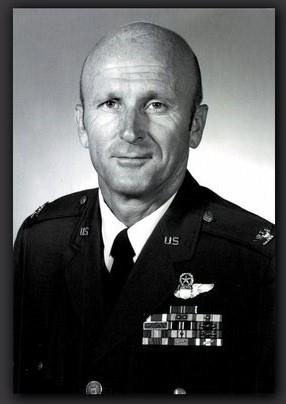
What should I have asked you?
Emergency bailout for the Radar Navigator was downward and if on-board the forth man exit was out of the RN’s hole.
Thoughts on range and bombload?
In-Flight refuelling made the B-47 a long range bomber and the bomb load varied according to the type of bombs carried, Nulear load was four to six bombs.
Which weapons did you deploy, and which was the most spectacular from the cockpit?
Never dropped a bomb in anger.
Unofficially what’s the fastest and highest and the aircraft was taken?
.95 Mach, 38, maybe 40 K.
Do you love the aircraft?
I felt very at home in the B-47
What was unusual about B-47 tactics and culture?
It was an aircraft built for the typical role of a bomber at high altitude, but evolved into a most effective low altitude penetrator.
What were B-47 pilots most afraid of?
Loss of an outboard engine on takeoff. A number of takeoff accidents for this occurrence happened. Two at my home Base in New Hampshire and others at other locations. It was discovered that the reaction of pilots to this was to use aileron movement to correct the loss of direction control. Photos later discovered the problem was exacerbated by use of aileron and resulted in a situation called “Roll due to Yaw”. Correction of only rudder would correct the roll.
Did B-47 pilots feel about the absence of defensive weapons?
There was a twin 20 mm cannon in the tail controlled by the Co-pilot.
Tell me something I don’t know about the B-47
Although it was built to deliver nuclear weapons, it had the capacity to deliver conventional bombs and missiles.
What was base life like? How did you unwind?
Ideal location for water and mountain sports. Very family oriented, but a very professional group of crew members. The first jet bomber that incorporated the new jet trained pilots into an older group, of prop driven pilots, both learned from the blending.
Hush-Kit gives its readers a lot, if you feel this massive effort deserves support then head over to Patreon and subscribe.
The Hush-Kit Book of Warplanes Vol 1 here and Vol 2 here

Interview with Convair F-102 Delta Dagger pilot
Deuces Wild!
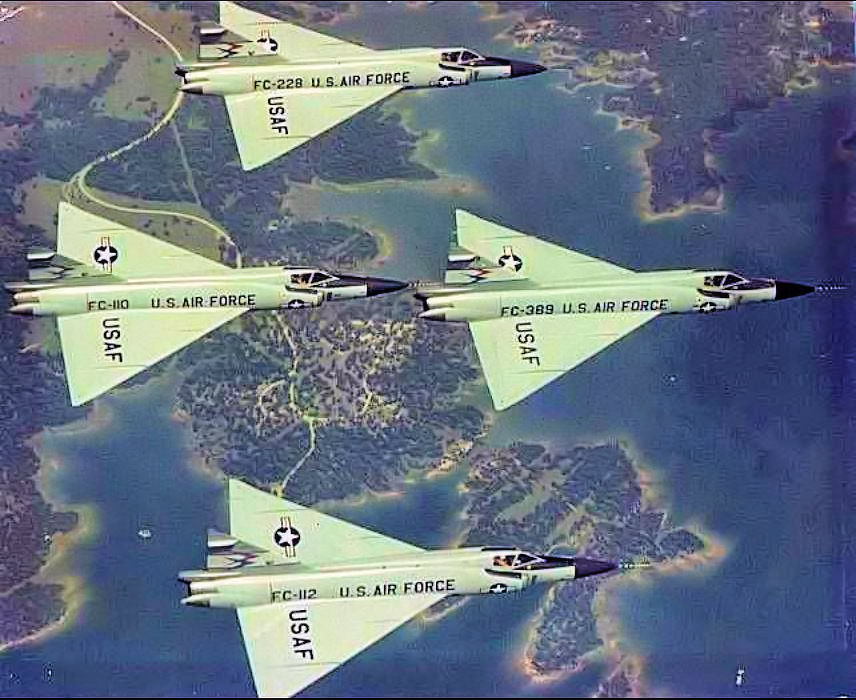
Incredibly, despite its futuristic appearance, work on the F-102 began in the 1940s. Tasked with intercepting Soviet bombers at a dangerous time in the Cold War, the F-102 was the tip of the spear for the defence of the USA. Colonel Dugard flew the F-102 for the 87th Fighter Interceptor Squadron of USAF in the late 1950s. Here he reviews the flawed but formidable F-102, a vital stepping stone to the excellent F-106.
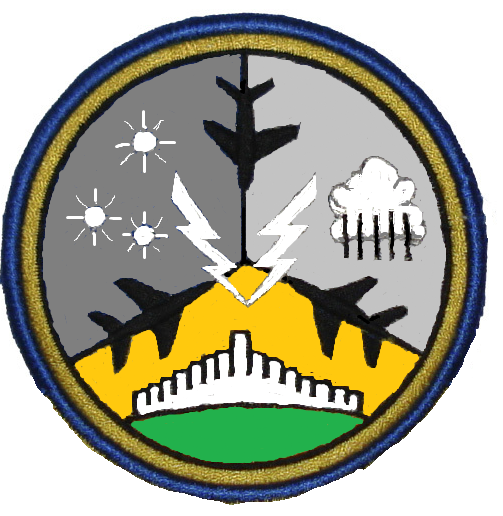
Describe the F-102 in three words.
Heavy Fighter Aircraft
What was the best thing about the F-102?
Delta Wing gave it great manoeuvrability.
..and the worst?
Heavy detracted from climb response.
What is the biggest myth about the aircraft?
That it was a good air-to-air combat aircraft
How good was as a dogfighter compared to other aircraft?
Could stay in contention if turning, but very vulnerable in climb
What was your most memorable experience flying the F-102?
Flying as a target aircraft for other F-102s. On a night mission with a low overcast and after a couple of intercepts I got a red weapon systems light. I broke off the mission and although not an emergency for flight, called the command post and was told to RTB (return to Base). I proceeded to the fix for a penetration to station. And was told to hold due to traffic in the area. After holding for a substantial period-of-time I was cleared to penetrate. I was placed in the pattern as #3 for landing. I noticed my fuel state was getting low and the yellow fuel-light came on. The fuel counter had not started to click down so I was comfortable with my state. Finally, I was cleared for a GCA approach. On final my fuel counter started to click down and was notified to go-around due to an aircraft problem. As I started my go around, I told them I had a low fuel state. Approach Control acknowledged the call, but then let another aircraft slip in front of me for landing. The RED fuel light game on indicating I could not make a go-around on the next approach. I asked for an immediate clearance to be given a priority approach. Not getting a response I called out “Mayday”, Getting their attention I was placed on final and completed the approach and landing, After clearing the runway and jettisoning my drag chute on the taxiway, the aircraft engine flamed out. I was towed to a parking slot.
What was the role of the F-102 and in which unit did you fly?
Air Defence Command, launched to intercept intruders 87th FIS
How would you rate it in the following categories
A. Instantaneous turn rates.
Good Delta wing, leading to good wrap up 90-degree bank angle turns.
B. Sustained turn
Hold it until you grey- or black out.
C. Climb rate?
Can peg 4k/min with AB to speed drop down.
D. General agility
Heavy fighter, not intended for much more than intercept.
E. High angle of attack performance
Will run out of airspeed with sustained High Angle of attack.
F. As an interceptor
Excellent
G. Cockpit layout
Very pilot friendly cross check for in-flight instruments
H. Sensors
Sensitive of and responsive to the presence of other aircraft.
I. In terms of combat effectiveness and survivability?
Good visibility forward and above. Survivable in its role.
J. Cockpit layout and comfort?
Comfortable, though seat packed chute has lumps.
What should I have asked you?
About how the low ceiling was not the best for an intercept aircraft.
Thoughts on the escape system?
Ejection seats worked every time.
Which weapons did you deploy, and which was the most spectacular from the cockpit?
Missile equipped aircraft. Most release were range released. Never fired at a live target.
Unofficially what’s the fastest and highest and the aircraft was taken?
Never busted Mach 1, but close. 37,000 feet.
Do you love the aircraft?
No, It was serviceable and a good flying machine, but never felt at home in it.
What was unusual about F-102 tactics and culture?
Typical fighter-oriented society. Alert oriented aircraft, called for rapid response and quick engagement.
What were F-102 pilots most afraid of?
Missile malfunctions
Did F-102 pilots feel about the absence of a gun?
We were flying an interceptor, and the weapons we had on alert were very adequate for our mission.
Tell me something I don’t know about the F-102
The ceiling limitations that I mentioned before.
What was base life like? How did you unwind?
Perrin AFB was located close to the big “D” and functions at the club were common.
Hush-Kit gives its readers a lot, if you feel this massive effort deserves support then head over to Patreon and subscribe.
The Hush-Kit Book of Warplanes Vol 1 here and Vol 2 here
It is time you ordered The Hush-Kit Book of Warplanes Vol 1. Vol 2 can be pre-ordered here.

Flying Hercules for the US Coast Guard

Steve Parker doesn’t flew the HC-130 for the U.S. Coast Guard. Here he gives us the low-down on the demanding life of a flying coastguard.
“You have to go out. You don’t have to come back.” That’s not some ooh-rah bullshit. It’s written in blood. It’s written in the blood of my friends.
Describe the HC-130H in three words
I don’t think one can describe the C-130 in three words. I don’t do bumper stickers. How can you describe love or women or anything that forms an important part of your life in just three words?
I was a US Coast Guard pilot, “aviator” to the purists, at Clearwater Florida, in the mid to late 1980s. But it’s a little more complicated. After a tour as a Coast Guard officer at sea on a destroyer-sized 378’ ship (a “cutter”), my flight training was by the U.S. Navy in a mixed class, as they always are, of Navy, Coast Guard and Marine pilots. In fact, all three of those services, when they earn their wings, are designated Naval Aviators. My particular orders read, “upon designation as a Naval Aviator, you are hereby co-designated a Coast Guard aviator.” I suspect it is the same for Marine aviators so that in wartime, when the Coast Guard used to be a part of the Navy (maybe still will be) all Coast Guard pilots are current naval aviators and can be plunked into Navy cockpits where needed.
After graduation from naval flight training, in an outbreak of common sense for which someone will be severely punished, I went to Little Rock Air Force Base for C-130 training. Using the same base and training personnel for all C-130 pilots regardless of service is a great idea but entirely untypical of how the military does things so, as I said, someone will probably be punished for designing a system so logical and economical.
Then, after a couple years on Navy bases and an Air Force base, with my newly issued wings and C-130 qualification, I went to Coast Guard Air Station Clearwater, Florida, to serve my tour.
How are HC-130H pilots different from USAF C-130 pilots? US Air Force C-130 pilots have a different mission, usually trash hauling. They practice formation flying (same day, same way) and assault landings. Marine pilots, I think, get specialized training as tanker pilots at some point, perhaps at their home base. All C-130 new pilots got the same basic transition training in Vietnam War veteran C-130 E models with battle-damage patches, mostly instrument flying, emergency procedures, and system failures. In the simulator, they love to give you simulated fin stall so you have to put 200 pounds pressure on the relevant rudder pedal.
What is the best thing about the HC-130H? The single best thing might have been that the technicians who worked on our aircraft were also the Coast Guard aircrew. They were so clean you could eat off the deck. Some Coast Guard pilots and aircrew had prior service in the Navy, Marines or Air Force and almost everyone would rate highly in any Air Force of the world. There was an informality and camaraderie between pilots and enlisted that I did not see in the Navy or U.S. Air Force. When we were flying out of Guantánamo, as we often did, the Navy officers seemed surprised and offended at the informality between aircrew members. That camaraderie lent an especially high morale that pay dividends when we flew into some of the worst weather in the world on search and rescue missions.
There are many good things about the C-130, including durability, flexibility for different missions, systems duplication for when things go wrong, and ability to operate under different operational conditions.
..and the worst? Two things come to mind. The landing gear is hull-mounted which allows her to turn sharply, and are designed to withstand assault landings (“take that, runway”) but they’re not designed to stand much sideload at all, so you must make sure to correct for any drift upon touchdown in crosswind landings lest you damage the gear.
We were taught that (at least by the mid-1980s) ditching the C-130 ended in everyone dying. We were told the sole exception was an Argentine C-130 that inadvertently ran out of fuel so that when she ditched she was at absolute minimum weight and maximum flotation potential due to empty fuel tanks. No one was killed as they ditched but half of them died in the brief time required to exit the aircraft.
Since we spent the vast majority of our time well out over the ocean, and since a number of emergency situations such as fuel or hydraulic based fires can render further flight impossible, I was glad that we had parachutes for all crewmembers. But right after I arrived to begin my tour, some genius bean-counter decided to save money by taking all of the parachutes off of our C-130s except for two, since the load master and drop master needed to wear a parachute as they supervised dropping pumps to sinking vessels or dropping emergency equipment in flight.
Given the inability to ditch, having only two parachutes for a crew of seven was a cost-saving idea for which someone should be shot. When I gave new crewmembers a tour of the C-130 I would point to the forward bulkhead of the cargo compartment, upon which were hanging the two parachutes and a full-sized fire axe. I would point the axe and ask them to identify it. They would say “fire axe” or “crash axe”. I’d say, “No, that’s the parachute selection tool. If you’re the first one to grab it [the fire axe], you’re probably going to get one of the parachutes.”

How do you rate the HC-130H 1710 series in the following:
A. Handling/agility As Steve Fothergill (I think) once said, using the C-130 for the air intercept work we did was like using a dump truck to do the work of patrol car. On the ground, she loaded easily using the ramp and door to the rear, and she taxied beautifully, making precise and tight turns. In the air, with a full bag of gas and a load of cargo, she handled about like you’d expect. One duty night training flights with a partial load of gas in the cool of evening she fairly leapt off the ground and was relatively nimble in air work for a transport class aircraft.
B. Take off run- varied wildly depending upon cargo load, density altitude, fuel load, runway surface conditions. The 1710 series aircraft I flew came straight from the factory so their engines were new and performed well.
C. Reliability – receiving brand-new aircraft from Lockheed can be interesting. I’m sure they had an acceptance flight at the factory and another acceptance flight there from a Coast Guard officer but complicated new aircraft always have little surprises that show themselves during initial operations. That said, despite being new aircraft, there were remarkably few bugs and the airframes and engines proved very reliable. Thirty years of operational use identified and eliminated most problem areas. Yes, you had occasional emergencies that necessitated engine shutdown but on the whole, she was very reliable.
D. Looks – she’s never going to win a beauty contest against the Mustang or Spitfire on a Concorde or a Constillation. She’s bulbous and had a big black nose. However, the paint job did what cosmetics could. She was bright white and clean with a big red and thin blue stripe for accent.
E. As a tactical transport – she worked well as a trash hauler and you could slide in seat pallets with airline-type seats and haul a lot of people.
F. As a para platform – we didn’t drop personnel, even rescue swimmers, out of the back of 130s. Rescue swimmers deployed from the H-3 helicopters we also had on base. We would paradrop high-capacity, gasoline-powered pumps (with fuel containers) in watertight 50 gallon drums to sinking vessels to help them stop and reverse flooding of their vessels. These drops were made at masthead height in some of the worst weather imaginable.
G. For aid work – the C-130 could fly into remarkably crude airfields with all sorts of palletized cargo.
H. Cockpit comfort – most C-130s have a large air conditioner in the cargo compartment and a small air conditioner for the flight deck. Neither of those does much good when you’re flying all day-every day, low-level search and rescue or maritime law enforcement patrols at low level, bumping endlessly along with the Caribbean heat blazing through the greenhouse glass the flight deck. Most C-130 flights by the Air Force in hot environments don’t stay at such low level and can take advantage of the cooler air aloft but we endlessly bored holes in the sky at low level during all-day searches.
Our 1710 series aircraft differed in having a normal, large air conditioner in the cargo compartment, and another identical-size air conditioner attached to the fuselage for the flight deck. Even the larger-than-normal flight deck air conditioner fought a losing battle under those low-level tropical conditions but we were very grateful that we didn’t have the smaller flight deck air conditioner of previous models. All the flight crew seats had sheepskin covers which made a big difference in how comfortable they were in both heat and cold.

I. Pleasantness of long flights – long flights at altitude were about as comfortable as you’d expect, except that as a turboprop we were flying in the 20s rather than the 30s of turbojet aircraft, so we went through a lot of weather that turbojet’s simply flew over. We frequently deployed to Guantánamo Bay, Puerto Rico, Panama, and other locations, from which we would take off, day after day, and fly low-level patrols over the Caribbean, for search and rescue, for migrant interdiction, in maritime law enforcement against drug smugglers. What that meant was beating along low above the Caribbean in the tropical heat. Imagine driving an old school bus for eight (or twelve hours on your last day) down a badly-rutted road with a million big potholes. Flying at altitude is usually quite comfortable. Flying low all day above the Caribbean wears you out.
J. Ease of refueling- we couldn’t do air to air refueling. The flight crew handled refueling while we were flight planning so I didn’t witness the process or deal with any of the problems that might’ve arisen. If we had the ready aircraft fueled for a training mission and were scrambled for emergency search and rescue, sometimes we had to hurriedly top up the fuel.
7. What is the biggest myth about the HC-130H? Hard to say. Perhaps it’s the nicknames aircraft enthusiasts attribute to her. I never heard anybody in the 130 community ever refer to her as anything except “130.” Certainly, no one called it Herky Bird or Hercules or Fat Albert (except for the sole aircraft of that name which supports the Blue Angels flight demonstration team).
Tell me something I don’t know about the HC-130H
At least one part, the floor the flight deck, was then made of wood. The chains that connected our flight yokes to the sprockets underneath the flight deck that were connected to the flight controls (and maybe the sprockets themselves) were made by the Harley-Davidson motorcycle company. During long flights, we used to quiz each other over such arcana. The pilots and flight engineer knew all the basic stuff, like all the backup systems and what was connected to an AC or DC bus and where the circuit breakers were, so we go beyond that to quiz each other about the most minor 130 trivia.
Describe your most memorable flight (long answer please) – the worst weather in the northern hemisphere is in the northeast quadrant of the cell wall of the Northeast moving hurricane. The cell wall is the most intense weather of the hurricane and surrounds the eye of the storm. One day, just as I was about to be relieved as the overnight ready crew, we were sent out to rescue a sinking ship which was under the Northeast quadrant of the cell wall of a Northeast moving hurricane. At the time of takeoff, we thought the storm had downgraded to a tropical storm but once we got in the thing, our navigator determined the wind strength from the Doppler and confirmed that the storm had regained hurricane strength.
You may have seen news footage of hurricane hunters filmed by local news people riding along, and the pilots keep their coffee cups in little holders that are like something you hang on the door of your pickup truck. Their coffee has tiny ripples as it jiggles and the reporter will point that out and say, “Oooh, it’s rough,” in the pilots will concur. Their placid ride is because they’re up above 20,000 feet and able to use the radar to pick their way between the convective towers.
In our hurricane rescue mission, we had no such flexibility. The sinking vessel was an offshore oil rig resupply vessel whose captain hadn’t had the balls to tell his supervisor that no, he wasn’t going to take his vessel and crew out into that terrible weather, and the offshore oil rig resupply folks are just going to have to wait another couple days further for their fresh food and personnel change.
The sinking vessel had to shut down its main engines as the flooding rose to the air intakes and due to the rising water in her engine room was about to have to shut down her auxiliary engines that powered the dewatering pumps. If she shut down for auxiliary engines and therefore, the pumps, she would have sunk in a few minutes. Under the catastrophic weather conditions, the likelihood of getting crewmembers into a life boat on that wildly pitching deck in great waves was impossible.
As we flew towards the cell wall of the hurricane, we started getting hammered in a manner for which no aircraft is designed. The thing that made me sad was knowing how the crew “knew” we’d get them back safe. The phrase, “I had infinite faith in men with wings until I got wings,” comes to mind. Our crewmembers were as fine as any young men that ever lived and there was a substantial chance we were all going to die trying to save the crew of a captain who didn’t have the guts to refuse to sail into her hurricane.
The official motto of the Coast Guard’s “semper paratus” (always prepared, as in to go into action immediately). The actual, real-life motto of the Coast Guard at the pointy end of operations, the fixed wing and rotary wing pilots, small boat crew, rescue swimmers, etc., is “You have to go out. You don’t have to come back.” That’s not some ooh-rah bullshit. It’s written in blood. It’s written in the blood of my friends.
As in all services, there are regulations specifying that when the weather gets above a certain intensity level, you have to abort the mission. No one ever does. We knew we were all they had. If we turn back because of the mind-boggling turbulence and off-the-charts flight conditions as we made our runs to drop pumps at masthead height, there was no else who could save these people.
We were literally swapping control between pilots every 45 seconds. That sounds idiotic and nonsensical but it happened. The extremely low ceiling, terrible visibility, and the requirements to make a successful pump drop meant you were at masthead height. In the wild turbulence the wing would drop on one side and you’d see it touch the water, or thought you did, but it must have cleared by a matter of inches because if you dug a wing tip in the water the aircraft would instantly cartwheel and you be dead. You’d wrench the wings level for an instant and then the other wing would drop and seemingly touch the water. On and on and on.

I saw the movie, “The Perfect Storm” thinking they would re-create through CGI effects the weather I witnessed. Nope. Not even close. I don’t think a movie could ever come close to the insane conditions experience that day.
We made four drop runs, dropped our four pumps, and the sinking vessel was able to recover two of them, and with them, reverse the flooding, She was able to stay afloat, and dewatered enough to get their main engines running again and they all survived. They sent us a postcard saying that if we had arrived 15 minutes later they would all have been dead.
I flew into oodles of terrible weather, because when wealthy people like doctors and lawyers buy airplanes or boats, some think that the weather will defer to them just like the people in their offices, and their planes crash or their boats are lost at sea in horrible weather, the Coast Guard had to go out in that same weather to save their ass.
Some crazy things that the HC-130 did? What was your hardest or most dangerous experience? I have one story that I relate because it may be of use of other pilots at some point. We were flying over the Bahamas in some extreme weather and the turbulence was terrific. The other pilot was flying that leg and without warning, he threw up his hands and said, ”You have the aircraft. I have vertigo!”
Needless to say, this is not the manner in which you transfer control of an aircraft. I took the controls, and said, “I have the aircraft. You have the radio.” He squealed in a little girl voice, “I can’t do the radios! I have vertigo!” Under the conditions, his scared response, I could feel the crew thinking, “Oh, shit!,” so I told him, “I have the aircraft and the radios. Shut your fucking mouth.”
Thankfully, he quieted down. Now I had to get us through the situation. I had not said anything, but I also was suffering intense vertigo. Much as the room spins around the college student who’s had way, way too much to drink, and gets the ‘spinny beds’ as the room seemed to spin around him, the world was rotating around me vertically as if I were spinning backwards at about two revolutions per second. It was nauseating and disorienting. The level of the turbulence meant that it was impossible to engage the autopilot, which could never possibly keep up with the wild conditions.

As the world spun around me, the steam guage instrument panel flashed down, from over my head to down below my feet twice a second. I thought, “If I fuck this up, were all gonna die.” As the instrument panel seemingly whipped past my face from top to bottom, I got a momentary glimpse of the attitude indicator, then the VVI, then the attitude indicator, the altimeter, the attitude indicator, the airspeed indicator, the attitude indicator- I was doing my instrument crosscheck as the panel whizzed by. My overriding thought at the time was, “I can’t believe this is working.” But it did.
I tell the story in case anyone else encounters extreme vertigo and nausea during flight. Even with the world spinning around you, it is possible to continue the instrument crosscheck, especially now with the integrated display of glass cockpits with attitude, altimeter, VVI, airspeed, and ‘ball’ all in one combined instrument display.

Of its rivals which comes closest and which is the worst? The C-17 was envisioned as a replacement for the C-130 but its expense and its inability to do some of the things C-130 can do means the C-17 fleet is a worthy supplement to the C-130 rather than a replacement.
12. What is the role of the aircraft? – For the USCG it’s an all-purpose workhorse. Trash hauler, long-range maritime patrol, long-range maritime search and rescue, ship and aircraft detection and interdiction ops for drug and people smuggling.
13. What kit should have been added to the HC-130? A glass panel, as I’m sure they now have. We had steam gauges. We had a flight director, but the LORAN and Omega navigation systems had been decommissioned in anticipation of upcoming “Satnav” (GPS) but there were not yet satellites enough to make the system work so as we primarily worked in the Caribbean and Central America, we used ADF navaids for some circumstances.
As each aircraft arrived from the Lockheed factory they had cutting-edge beautiful King digital ADF. The first thing that happened to each aircraft as it arrived was the avionics maintenance people would pull out these beautiful, brand-new King digital ADF and install in its place an old World War II type coffee-grinder ADF. These work better as thunderstorm finders then for finding navigation aids, and it was a constant pain in the ass to keep turning and retuning and retuning them as the receiver wandered off frequency.
Why, I would ask, are you removing the state of the art King (the best avionics manufacturer of the time) digital ADF and replacing it with its problem-prone dinosaur-era predecessor? They told me it was because they could fix the old ADF if something went wrong. I couldn’t convince them that the new units were under warranty and unlikely to fail and that we needed them for critical navigation in Central America. Someone up the food chain in the avionics maintenance department had made a decision and we never saw the King ADF units again.
My present single-engine Mooney M20R has a Garmin G1000 glass cockpit with GPS nav and approaches and it’s infinitely preferable to steam gauges.
14. What should I have asked you? Do I miss those days? I miss the people. I don’t miss flying in some of the worst weather in the world when the other services are displacing their aircraft away from approaching storm systems, we were flying into the teeth of the storm to save some dumbass who didn’t have the sense to stay on the ground or in harbor during terrible weather.
As in all services, the personnel who don’t fly or crew boats tend to be petty self-serving, butt-covering, empire builders and ladder climbers who exists only to advance their own careers and those of their friends rather than accomplish the mission.
When Coast Guard aircraft or ship is lost and the crew killed, the unit commanding officer and their commanding officer used to get the axe after an investigation. Consequently, the Coast Guard passed a bunch of regulations saying that if the weather conditions exceeded certain parameters that the mission had to be aborted and the aircraft or ship returned to base. In real life, knowing we were the only chance someone in distress had, we never turned back. Consequently, when Coast Guard rescue aircraft are lost, the investigation declares it due to pilot error, since the pilot continued operations in adverse weather conditions beyond those allowable.
It’s just a disgusting way to cover the ass of higher ups who can blame the loss on the flight crew and protect their own career. As I said, the real motto of the Coast Guard is, “You have to go out. You don’t have to come back.” It makes me bitter beyond words to read investigation reports where crews sacrificed their lives in an attempt “that others may live,” and see the mealy mouth investigators attribute loss to pilot error.
I don’t remember being scared regardless of the flight conditions. I do remember being sad to the depths of my soul on those occasions when I thought I would not be able to bring my crew back home alive. The crew had such infinite confidence that you would keep them safe and I knew the substantial chance I would not be able to do that if we were unlucky. I resented the fact that my flight crew, the best and brightest, that their lives might be forfeited trying to save some idiot who took their airplane or boat out into terrible weather because of their stupidity or misplaced self-confidence. It would’ve been a terrible bargain to throw such young lives away for fools. Had I been lost, my young family would probably receive better benefits than the families of the enlisted crew since I was an officer. I worried how their young families would survive at things turned out differently.
Costner & bullshit
One unrelated note. In Kevin Costner’s 2006 movie, The Guardian, their Coast Guard HH-60 is headed for a rescue at sea off Alaska. They develop a ‘chip light’ (or some other engine system malfunction indication) and elect to proceed with the rescue operation anyway. That is realistic, and shows the real-life dedication of Coast Guard crews. But in the movie, the Coast Guard C-130 orbiting the vessel says they must return to base because they are low on fuel. I almost jumped up in the theater to cry, “Bullshit!” If you had a helicopter enroute to a rescue hoist, if they had a chip light or not, there is no way ANY Coast Guard C-130 would abandon them. If the chopper goes down, the 130 has a raft to drop and can guide in rescue craft. If I (or any 130 pilot) had been in that situation, low fuel be damned. I’d shut down an engine to save fuel. Hell, I’d shut down two if I had to, but I’d never, ever abandon my brothers and sisters.

God’s work

Helicopter pilots are the fighter pilots of the Coast Guard. We gave them endless ribbing in the fixed-wing vs. rotary-wing banter, but theirs is the real God’s work. No greater love, and all that. To brave storms to hoist an injured or sick crew member with the ship’s mast swinging wildly about, helo pilots and rescue swimmers and crew are amazing. It’s different work than night traps in weather in a battle-damaged F-4 or suffering artillery barrages in Ukraine today or during the Great War, or winkling Japanese out of their bunkers on Iwo Jima but the heart required for all those is the same.
BUY THE HUSH-KIT BOOK OF WARPLANES HERE
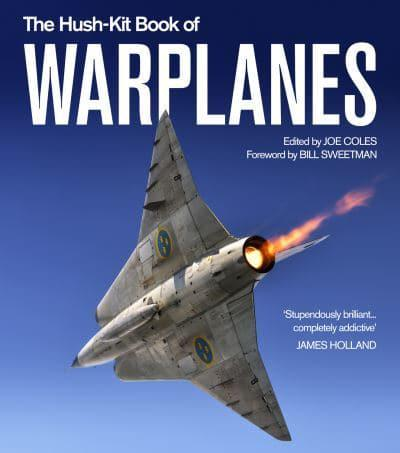
VOLUME 2 is now fully funded and may be pre-ordered here.

Interview with Cold War Saab Draken pilot
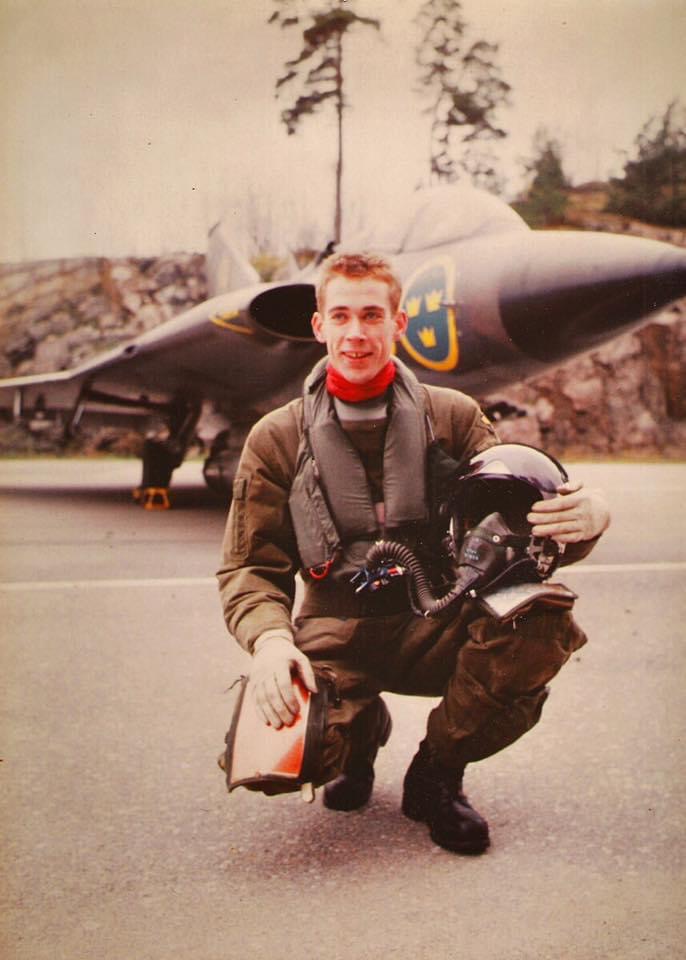
A masterpiece of fighter design, the Saab Draken was a sleek flying dagger designed for the defence of Sweden. Long before the MiG-29 made it world famous, the Draken was capable of the alarming Cobra Manoeuvre, in which the aircraft snaps its nose beyond a vertical attitude (without losing or gaining altitude). In this dynamic deceleration the entire aircraft acts like a giant airbrake forcing any pursuing fighter to instantly become the pursued. Bosse Engberg flew the majestic Saab Draken for the Swedish Air Force in the 1980s. Here he gives us the low-down on the sleekest of all European Cold War fighter aircraft.
Describe the Draken in three words
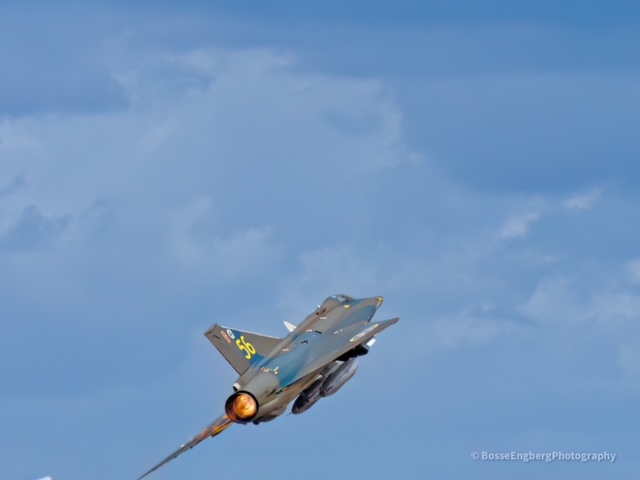
Reliable
Unique-design
Sports-car
What was the best thing about the Draken?
The feeling of being one with the aircraft once you closed the canopy
…and the worst?
None (as I can remember)
What is the biggest myth about the aircraft?
I’d say it was the ‘Superstall’ – which was reality and not a myth. It could be used for the ”Cobra manoeuvre” during dogfights.
What was your first flight like?
We started off in the twin seat version (SAAB 35C). The first two flights were demo flights, seated in the backseat. Coming from the SK60 (SAAB 105) everything happened twice as fast but after a few flights you got used to the experience and had time to start enjoying it.
What was your most memorable experience flying the Draken?


As Sweden was a neutral country, placed between Nato and the Warsaw Pact we always practiced on our own. However, being based closed to the Baltic Sea, there were often things going on. My first experience happened when we were out as a two-ship, practicing low level dogfight over water. My leader (and instructor) was called and asked if we could perform at identification of an unknown low level object. He acknowledged and we were lead by radar towards the target, flying at 30 meters and speed M0.9+. Having less than 100 hours on the type and experiencing your first “mission” increased my pulse significantly. All of a sudden the object appeared – for my leader. I was concentrated following him but was not prepared when he fully extended the speedbrake and went to idle. I passed him and when looking forward I saw an Ilyushin Il-18, painted in Aeroflot livery, over water at 50 metres! Of course I passed that one too, with full speedbrake, idle and now even higher pulse. I realised I had to get in position behind him again so I made a climbing left turn. Stupid enough I crossed his flightpath, meaning “follow me”, and so he did! For a short while until someone else took command and turned back to the easterly heading they had before my manoeuvre. I got back behind my leader, this time with more suitable speed, and we informed the radar operator about type and registration. Running low on fuel we left him and returned to base. The older guys had some good laughs on my behalf at the debriefing. It would have been a good catch though, bringing home an Il-18 in my early career.

What was the role of the Draken and in which unit did you fly?
We were 99% fighters but with the capability to load and launch rockets at special occasions.
How would you rate it in the following categories”
A. Instantaneous turn rates
Quick to react, easily pull 9G
B. Sustained turn
Speed decreasing quite rapidly (with high G load) since the shape of the wings produced a lot of drag
C. Climb rate
Good but have nothing to compare.
D. General agility
A somewhat small and manoeuvrable fighter, quick responses and easy to fly – but you had to be cautious in low speed.
E. High angle of attack performance
Unstable as the double delta shape quickly could throw you in to superstall. If I remember right, we had an α of 12-15˚ in the landing.
F. Off-base operations
Sweden had a strategy of using normal roads as supplementary landing strips in case the runway at the base had been destroyed. Landings were practiced now and then, the first times an awkward feeling with high pine-trees standing close to the strip.
G. As a fighter
As it was the only role it was assigned for and I’ve only fired rockets a few times it’s hard to tell. It drank quite a lot of fuel in low level flight so any longer missions were not possible. So as an attack aircraft it was only considered as a last option.
Sensors
We had an IR-sensor on the F2 version.
In terms of combat effectiveness and survivability?
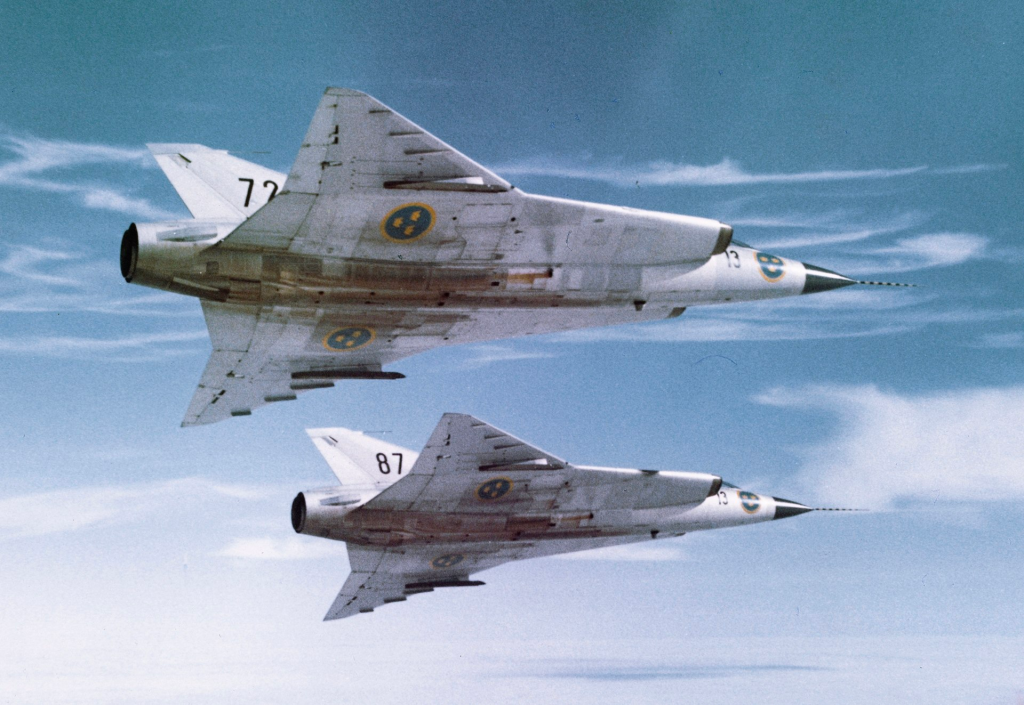
This is quite hard to tell since the Draken never has been in combat for real. I know occasions that has taken place “for fun” over the Baltic sea with other countries fighters and performed well.
Cockpit layout and comfort?
Old fashioned layout, only analogue instrumentation. The comfort was good, you somehow “put the aircraft on you as a jacket” when you climbed down. It was tight, especially if you had your drysuit on. Then you had to perform some checklist items with your elbow. The chair was leaning at a comfortable 35˚.
What should I have asked you?
Was it hard to land? It was, in the beginning. Coming from a trainer with nose-down during approach the high AoA was a new experience. Rising the nose immediately required more thrust. Also the fact that you had to look somewhat sideways “around” the instrument panel to see the runway was initially an awkward feeling.
Did the aircraft have a nickname?
Not really but we all had our names and feelings for the Draken.
Which weapons did you deploy and which was the most spectacular from the cockpit?
I only had the chance to fire one Sidewinder (AIM-9B) and one Falcon (AIM-26B) during practice. We also practiced the ADEN cannon once a year. No particular sensation when firing the robots (missiles) just a short “swoosh” when they were fired. Firing the cannon was a different feeling since it was noisy and you saw the tracers.
Did you fly DACT?
We did not.
Do you love the aircraft?
But of course! It was love at first sight when I was 10 or 11 years old. To have the chance to fulfil the dream becoming a fighter pilot was extraordinary. Now living close to Swedens largest Draken museum is perfect, visiting once in a while to relive the specific smell.

What was unusual about Swedish air force tactics and culture?
As mentioned earlier, we could fly from roads in case of war being re-fuelled and re-armed on a small apron in the forest.
Bosse Engberg/lieutenant/F16 Uppsala (based two years at Tullinge, south of Stockholm/5 years flying Draken (version F1 & F2), in all 7 years in the airforce (1981-1988).
Hush-Kit gives its readers a lot, if you feel this massive effort deserves support then head over to Patreon and subscribe.
BUY THE HUSH-KIT BOOK OF WARPLANES HERE

VOLUME 2 is now fully funded and may be pre-ordered here.

The good, the bad and the ugly truth of the RAF C-130 Hercules
Interview with RAF C-130 Hercules pilot David Thombs
After 57 years of outstanding service in both K- and J-form, Britain’s Royal Air Force has taken the unpopular decision to retire the beloved C-130 tactical transport. Former RAF C-130 pilot, David Thombs, reveals the good, the bad and the ugly truth of the C-130.
“Wherever you find a war about to start there are always two aviation constants: the KC-135s will start appearing in strange places – and the world’s Hercules will start moving.”
BUY THE HUSH-KIT BOOK OF WARPLANES HERE
VOLUME 2 is now fully funded and may be pre-ordered here.
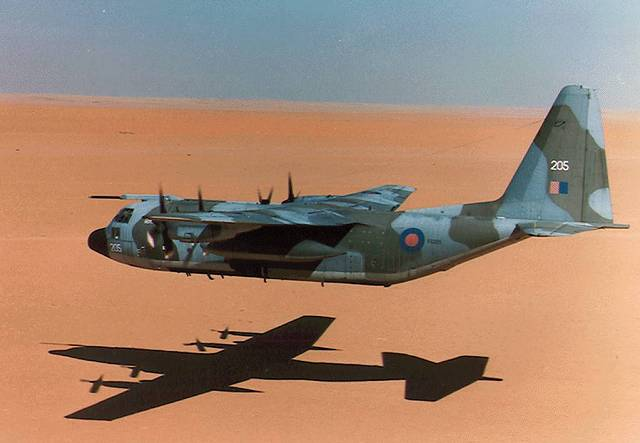
Describe the C-130 in three words: Ubiquitous, adaptable and loud.
What is the best thing about the C-130? Wherever you find a war about to start there are always two aviation constants: the KC-135s will start appearing in strange places – and the world’s Hercules will start moving. Usually this will happen with a bunch of bodged on modifications, loads that aren’t yet cleared for carriage and or a stick of paratroopers that are out of currency. Above all, despite outwardly appearance, inside the thing it’s as noisy as hell, all Mks, no exception. Our Ground Engineers had to pass a Hercules GE Sim ride as part of their selection. It involved getting in a hammock in a cupboard under the stairs and switching the hoover on alongside. If you could sleep for six hours, you were in.

In which air arm did you fly and which unit? When?


Royal Air Force between 1989 and 2004. LXX Sqn ’93 to 99. Handling Sqn 99 to 2002 then 24 Sqn 2002 to 2004.
How are C-130 pilots different to fighter pilots? We were always described as ‘Aggressively below average’ by our small jet colleagues. That said you had to be good at:
A. Flying a big aircraft. Sound obvious but handling a C130, double asymmetric in a cross wind requires good hand eye coordination. Dropping people and stores at 1.1 vs at FL250 whilst depressurised could focus your mind somewhat too.
B. Crew management. It’d a team effort. Some of the best Captains never touched the controls. When things get tough, let your mate in the right-hand seat keep things the right way up whilst you do the big picture stuff.
C. We didn’t argue the toss over who was the greatest at the end of every trip. No need, we knew it wasn’t us.
Low speed handling. You could do a wing over in a Scottish glen in the thing if the weather closed in. Super stable at 1.25vs (Tac VaT and usual drop speed) and superb acceleration away if you needed it.
Low-speed handling. Stalling was bad. Power on there would be no buffet just a huge increase in rate of descent, later models suffered bad wing drop leading to complicated stick pusher/shaker systems being used. Don’t whatever you do apply the rudder in the wrong direction when asymmetric. You can build up and aerodynamic spring type force that when corrected caused a USAF aircraft to go in backwards. Losing speed. Residual thrust, especially from the Rolls-Royce engines on the J was high. No airbrakes meant losing speed on approach was difficult which is very unusual for a big turboprop.
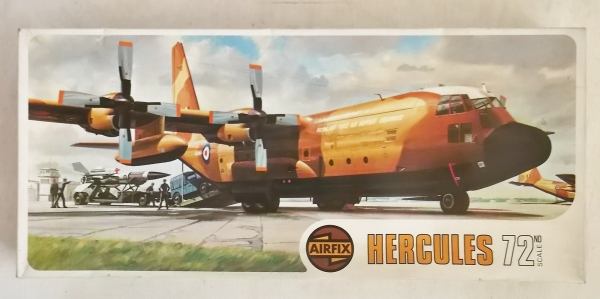
C-130 Mk1/3 assessment
Handling/agility
A. Pitch and yaw were great but the ailerons were too small. Tac landing speeds had to be raised because of this. Issues behind a VC10 with roll control from tip vortices. Elevator and rudder were powerful enough to overstress the aircraft at most speeds. At low speed the rudder was the primary lateral control with the ailerons used solely to keep the wings level. Surprising good at turning but never roll and pull at the same time as it stresses the ‘armpits’. Doesn’t mean you can’t roll then pull to 2.5G though.
B. Take off run. At light weights it could be quite startling how quickly it could get to rotate. At higher weights and in hot weather and at altitude it suffered like everyone else. Good on grass, sand, ice and snow.
C. Reliability
Hmmmm. If it needed to get airborne most things were doable without or fixable. Usually not entirely in compliance with the AMM. The GTC could be started with a broom and a match, the battery busbar could be connected to the main using the grounding lead and crocodile clips whilst in flight. The engines could be slipstream started or windmill started by charging down the runway. But they were old and things broke occasionally. Usually in Nellis.
D. Looks
‘A face only a mother could love’ according to a Lockheed advert in Flight Magazine. Hard to argue.
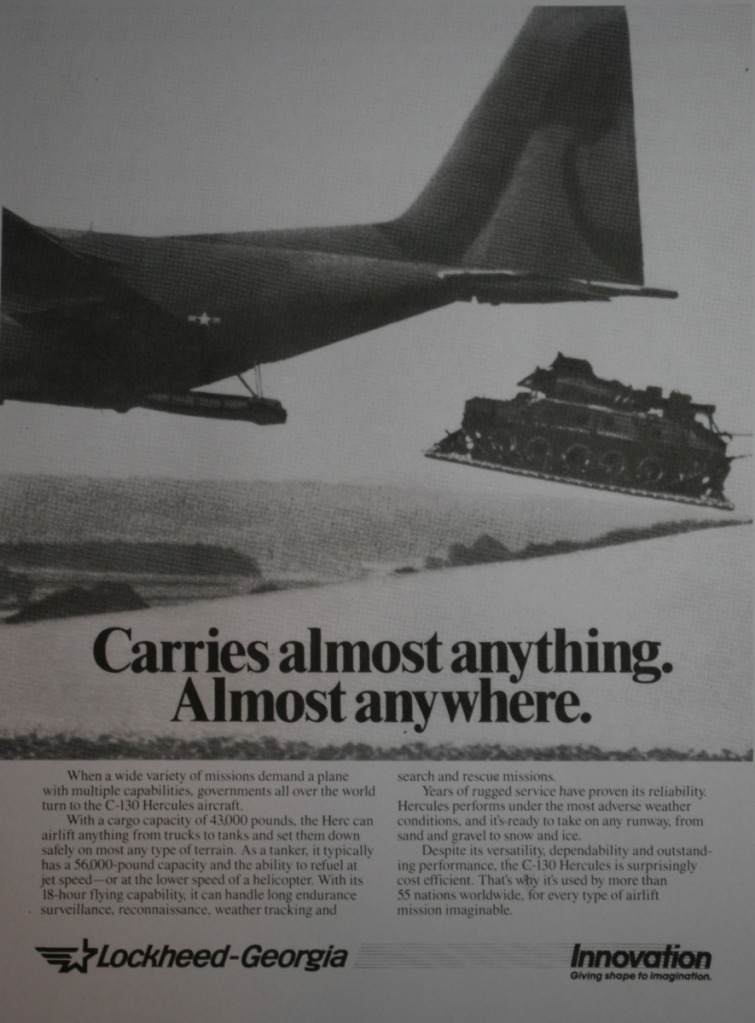
E. As a tactical transport
As a tactical transport it initially suffered from ‘bulking out’ issues as really weight of a load wasn’t an issue. Hence the stretched Mk3 that addressed this but caused tail clearance issues later down the line on strips. Station Keeping Equipment allowed formations of up to 20 aircraft (that’s all we had with it) to maintain formation integrity when IMC, even up to release. HAVEQUICK etc allowed us to talk to anyone. Defensive aids became more and more effective as the aircraft aged and peaked with the C130Js. NVGs were used for airfield assaults and even 15’ heavy drops. I once played golf with a chap who tested the pilot retrieval system in the USA. Possibly a step too far….but they were successfully employed catching rolls of film dropped by satellites.
F. As a para platform
All things considered; I think it was the best para platform out there. Yes, the C-17 is bigger and faster but only carries a couple more troops. No idea about the A400 only that it has initial slipstream issues. OC 1 PARA once told me that he preferred the Dakota as if I managed to crash one he would only lose a few men rather than 80 odd, but some people are just strange. You could drop people from upwards of 25,000’ down to 300’ if they were brave. HALO, HAHO and the Canadian Tube all used in anger around the world.
 | |||
The Canadian Tube was a large wooden tube full of stores with a drag chute to slow it to human terminal velocity. It was chucked out the back followed by some enthusiasts that were either attached to it or steered it with fancy gloves. Usually went out in the 20,000’ bracket with an opening height of around 1000’ to avoid anyone hearing the crack of the parachutes. Sometimes as low as 400’ if needed. Through cloud and at night. Hypoxia always a worry amongst everything else. Brave people
Aid work Perfect platform, no requirement for a prepared operating base or a need for a runway near the area in distress, just chuck the stuff out the back. Interesting piece of work done by the Belgiums on aid dropping. In Kenya the RAF gleefully dropped grain etc from 50’ watching it bounce and explode its way down the DZ. The Belgiums slowed right down and dropped it from 1000’. The bags soon lost their free air forward throw and hit the ground largely vertically and amazingly remained intact, presumably much to the relief of the people trying to pick them up. Aid work can be messy, any aircraft that you can hose down both inside and out at the end of the day is a winner.
H. Cockpit comfort

Biggest and best seats in aviation. Plus two beds on the flight deck. Difficulty was, staying awake.
I. Pleasantness of long flights
As above. Comfy but slow and noisy. Toilets terrible if even fitted. Great view of the world. Food usually great from Lyneham or from hotels. Just sit back, close your eyes and imagine a party heading towards you at 0.42M.
J. Ease of refuelling
AAR was difficult. Behind the VC10 we lacked speed and the engines would often become temp limited forcing a ‘toboggan’ descent to give the C-130 some overtake. Roll behind the 10 was a bad thing because of the vortices from its wingtips requiring left and right to be carried out using your feet. The slow speed basket was even worse, the VC10 would put out slats, aileron upset would activate and the thing would try and shake poor old Albert to pieces. Lost two HF aerials doing that.
What is the biggest myth about the C-130? You can put the engines into reverse in flight. Best not to really.
Tell me something I don’t know about the C-130
They float very well. A Columbian C-130 ran out of fuel and ditched. It was subsequently towed toward harbour but never quite made it.

My most memorable flight
So this is a long story. Back in the day, the House of Commons Armed Forces Select Committee would spend a couple of days on a Jolly Boys outing around the MoD. Back in ’96 it was RAF Lyneham’s turn to provide the entertainment and, perhaps unwisely, the Station Commander asked the mighty LXX Sqn to do the honours. At this point it should be pointed out that whilst no one was actually hurt during the day we all needed a long sit-down afterwards.

The day started early. The MPs and associated minders (none below the rank of Air Cdre for heaven’s sake) were awaiting us at Lossiemouth after a day of fact finding and a night on the raz. We launched as a 3-ship from Lyneham using SKE to get us above the weather before settling down to a late breakfast during the transit up north. A gentleman’s arrival over the fast jet community ensued followed by a nice lunch in the Mess. All was good.
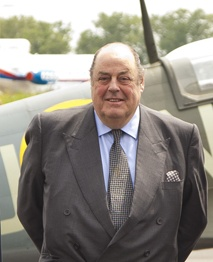
Post-lunch, the MPs boarded. I got Nicholas Soames amongst others. Off we set, down the Great Glen at 250’ to a chorus of disapproval and associated vomit as it was a little bumpy. Un-deterred we pulled out of low-level and went in search of a VC10 that we’d booked over the Irish Sea. Sure enough, it was there, heading the wrong way and not showing any signs of slowing down for us. The leader asked him to perform a couple of S turns to help us out. This is where things started to go awry. Whilst myself and number 3 cut the corners to catch the 10, the leader just followed his ground track which went we met, rather unbriefed at the same altitude in the same place. Much to everyone’s amusement. Recovering our dignity, we tanked from the 10 before gratefully seeing it push off back to Brize to leave us on our way.
Once again we failed to learn from our errors. Back into low level at Llandudno looking for the A5 pass had our guests again regretting their 4th Merlot earlier. Back up to medium level for a brief tour of Wales then on the way to Pendine Sands. Now I know that landing on a beach is all the rage now but it wasn’t then. People had concerns about the tides, markers and the unexpectedly large crowd that had gathered where Babs met its fate, hopefully not in expectation of similar excitement. Luckily nothing really went wrong and we soon had 3 C-130s taxiing around on the beach looking nervously at the tide and wondering whether we’d actually done enough research into sand based acceleration performance given the rate of deceleration we had experienced. Still we got airborne and I slung in a swift 60° AoB departure as I knew my Uncle Bernard was in the crowd.
Down the Bristol Channel we went and back to 250’ on the run in to the Salisbury Plain Training Area. We were full of two Medium Stressed Platforms each, around 30,000 lbs in weight. We kept things gentle as the loads were unrestrained and ran into Keevil DZ for a nice elegant drop. Subsequent recovery to Lyneham was reasonably uneventful although we appeared to have, once again, attracted a largish crowd of what we hoped were well-wishers.
That wasn’t really the case. Dear old 101 Sqn had raised a couple of issues (as had the chap in charge of DERA Pendine). My Uncle Bernard seemed happy but it turned out he was in somewhat of a minority. Determined to limit the damage the MPs and high paid help retired to the bar. Didn’t end well as it turned out. People had been drinking in there for a while.
Flying on NVGs was interesting as the early aircraft were not designed or modified effectively for it. Drop heights down to 15’ were common. High altitude parachuting, IMC formation flying and AAR (both giving and receiving) were day-to-day events. When combined with a requirement for every crew to be current at all times in worldwide route operations it was quite a thing to keep on top of it all.
Of its rivals which comes closest and which is the worst? C-17 can drop a load heavier than a C-130 max landing weight from a speed below the C130 stall speed. Truly excellent thing. The Transall was a horror show as was some of the stuff Antonov produced.
The Transall was just so slow. I only ever overtook three aircraft in an airway, a Mk3 C130 when I was in a Mk5, a Transall and a Dakota. Very strange flat flightdeck where only the pilots appear to be able to see out. The French scared me to pieces in one at low level leading an RAF C-130. As the weather closed in they slowed right down which was impressive as flat out the thing only managed 180kts then started circling. Our aircraft behind got a face full of Transall before pulling out into the cloud. Something to do with the lack of low level Air Traffic Control in France apparently.

The An-12 literally fell to pieces in my hands. We had agreed a slightly illegal co-pilot swop the night before in Ancona during the Sarajevo airlift which I started to regret when I was told to always wear a hat to avoid getting hydraulic fluid in my hair. Next was setting the millibar setting on the peculiar altimeter with a screwdriver as the knob was by now somewhere in amongst the control runs under the seat. Still, the chaps seemed unconcerned, the food was great and apparently there was absolutely no requirement to flare the thing, it kind of just gave up flying and belly flopped down. That said, it was better than the Transall, felt like it was made out of concrete.
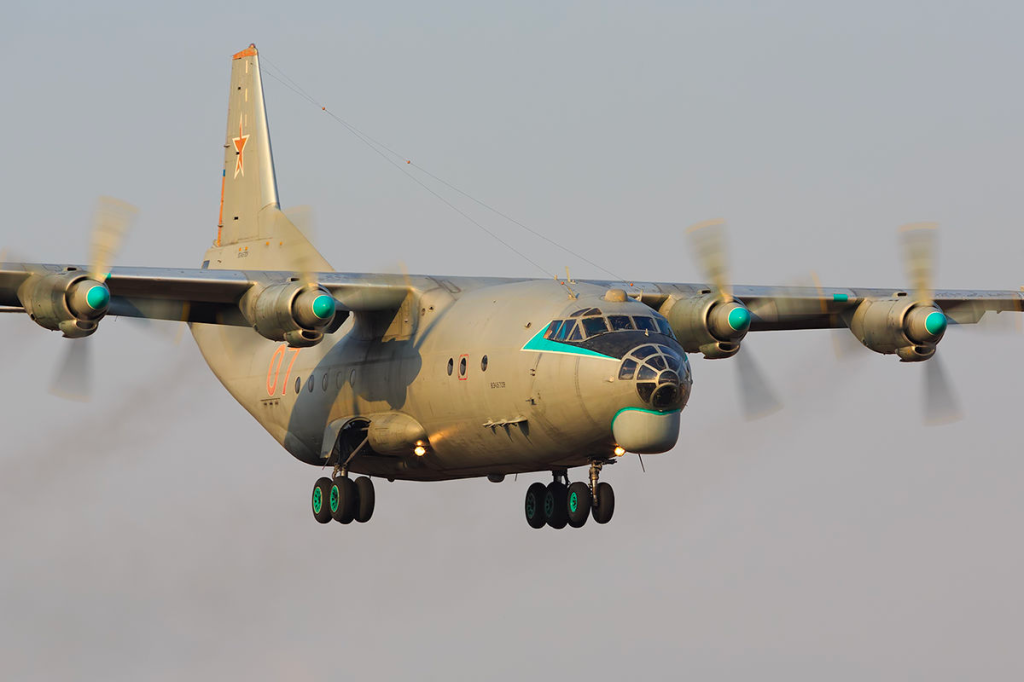
Your opinions on the RAF’s C-130 retirement and the A400M? The German AF is still buying C-130s and we are selling ours, read into that what you will. There are a lot of customers for ours as well. Ask yourself why there are so few in museums or guarding gates. The A400 is expensive and has a long way to go. Let’s give it the benefit of the doubt for now.

What kit should have been added to the C-130? Airbrakes please. JATO rockets. That cruise missile dispenser built by Lockheed. Bigger ailerons and a decent toilet. Perfect otherwise.
Some crazy things that the C-130 did?

Have a quick look at NVG TALO, SKE, Khe Sanh and all that kind of stuff that only the C-130 ever really did. ULLA was pretty scary at night as were the night clubs in Gander and Goose along with the bar staff at the Akrotiri Arms.
BUY THE HUSH-KIT BOOK OF WARPLANES HERE
VOLUME 2 is now fully funded and may be pre-ordered here.



